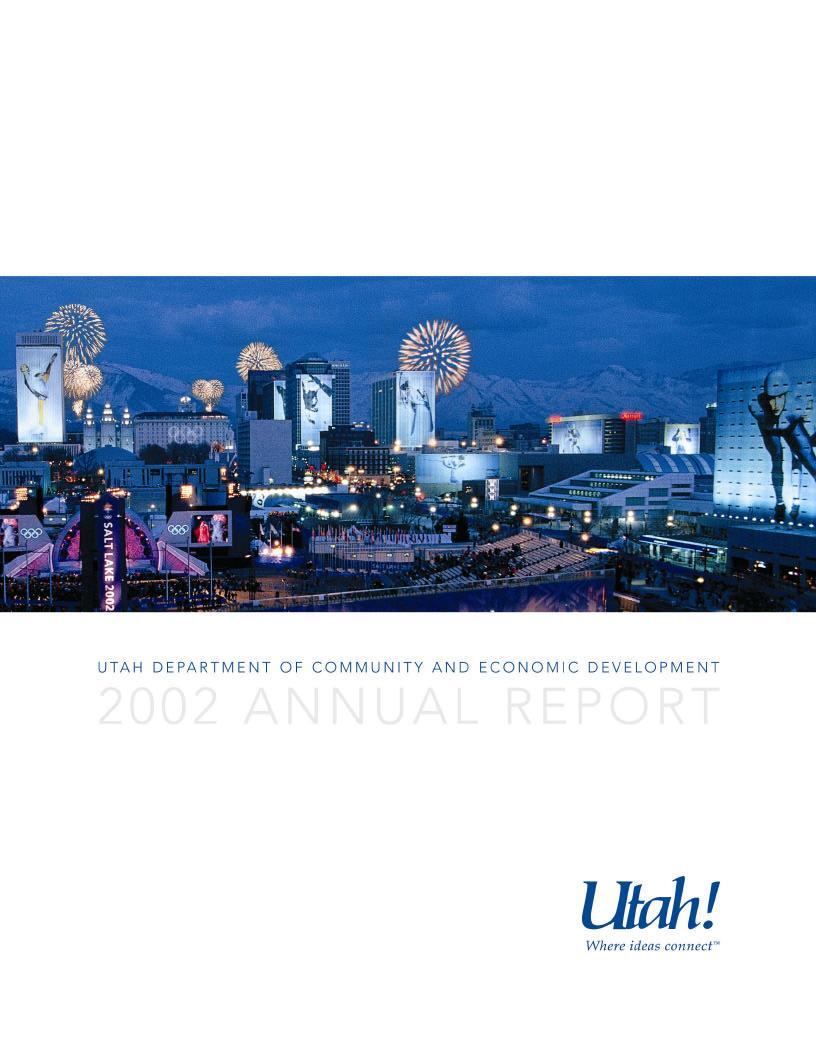

Executive Director’s Message
2002 was an amazing year for the Department of Community and Economic Development. Employees from our seven divisions mobilized to host dignitaries, hundreds of corporate guests, and reporters from around the world for the 2002 Olympic Winter Games. DCED established the Utah Business Club at the Devereaux to network with business executives, facilitated the establishment of 20 Country Centers for international guests, organized a series of business receptions in cities along the Torch Relay route, and provided facilities for print and broadcast journalists at the Utah Media Center. It was an Olympic effort! Coverage of the games put Salt Lake City and Utah on a worldwide stage. Our Division of Indian Affairs helped stage an unforgettable performance highlighting the state’s Native American heritage during the Opening Ceremonies. Thousands of flag waving Americans were exposed to the Utah! Where Ideas Connect brand as the brightly colored Utah van rolled through the streets of 46 states along the Torch Relay route.
Our efforts to leverage the games continue while the awareness of Utah remains high. Hundreds of new high-tech jobs have been created since Governor Leavitt launched his 1000-Day Economic Plan in February, including high paying positions at Smart Sites in rural Utah. The post-Olympic momentum continues in FY 2003 with the Utah! Trade Missions that take business leaders to more than 20 domestic and international cities, in addition to our ongoing advertising and marketing efforts.
We are also proud of our recent efforts to improve the state’s quality of life as we look for ways to enhance the arts, preserve Utah’s history, attract more out-of-state visitors, expand library services, provide more affordable housing and assistance to communities. Our department continues to provide taxpayers with a high level of service, even in these challenging budget times. Many people have asked us if we’re glad the Olympics are over. Our response is that we’ve never been busier as we continue our efforts to turn the rings into business links.
DaveHarmer Executive Director
1
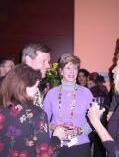
DCED Olympic Participation
Olympic Accomplishments by the Numbers
1. Hosting
· 350 venture capitalists
· 60 world leaders and seven members of President Bush’s Cabinet
600 corporate guests

79 events at the Utah Business Club at the Devereaux Mansion involving 8,000 local and out-of-state business executives and 42 Utah companies
The Utah Business Club hosting was accomplished under budget without using monies allocated for Olympic Winter Game use
$1,000 raised in tips from coat check at the Utah Business Club goes to Rose Park Elementary School
· 250,000 visitors/1.2 million visitor days
2. International
· 44 Countries Hosted at Receptions
· 76 Countries With Dignitaries Hosted

2
· 98 Total Partner Events
84 Total Events were DBED Partnered or Co-Hosted
Number of People at the 84 events = 18,385
Number of Guest we put in the events = 7668
20 CountyCenters
174,550 People through the Country Centers
· Web Hits = 2,043,551
· 28 Countries users accessed Countrycenter.net
· 42 US State users accessed the Countrycenter.net site
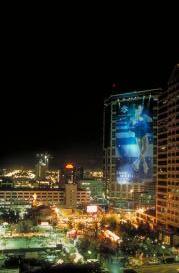
· Early Outcome $50 million in new venture from the Global Venture Program. Estimation of $125 million in total to be generated
3. Torch Relay
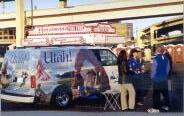
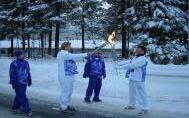
a. Utah Van traveled with the Torch Caravan through 46 states in 65 days
b. An estimated 1.5 million people saw the Caravan and Utah van with an estimated $9 million value in transit advertising to the State of Utah-DCED
c. Governor / Lt. Governor hosted receptions in 9 states along the Torch route
d. 26,000 invitations were sent out to Torch receptions with 4,000 reservations and 3,000 attendees heard the Utah Message
4. The Utah Media Center
a. 1,800 registered journalists from around the world

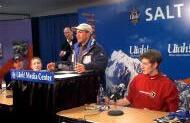
3
DCED 1000-Day Economic Plan Milestones
Governor Mike Leavitt launched his 1000-Day Economic Plan to renew the state’s economic momentum on February 4, 2002, the day the Olympic flame arrived in Moab, Utah.
ß Day 1, February 4, 2002, the Utah Media Center is on its 21st day of operation. The facility opened on January 7 at the Expo Mart in downtown Salt Lake City to provide working facilities and information for Olympic journalists. An estimated 2,215 stories, reports and packages were filed by network broadcasters. Politicians, Olympic athletes, celebrities and others hold news conferences at the Media Center during the Games.
ß Day 8, February 11, 2002, LearnKey, Inc., a St. George-based firm producing self-paced, interactive IT learning tools, confirms a donation of $437,800 in training materials to the Utah Smart Site program, Governor Leavitt’s initiative to create technology-based jobs in rural Utah.
ß Day 21, February 24, 2002, the Division of Travel Development’s TV spot market ad campaign reached 6.1 million people in Los Angeles, San Francisco and San Diego during the closing week of the 2002 Olympic Winter Games. The campaign featured Utah as the officialOlympic playground before, during and after the Games to leverage higher awareness of the host city into higher visitation to Utah.
ß Day 25, February 28, 2002, Utah’s Home Energy Assistance Target (HEAT) program serves about 33,000 households, exceeding last year’s record. The program helps low-income and elderly residents pay their winter home heating bills.
ß Day 37, March 12, 2002, the State Library Division released the new Public PIONEER website. The new site provides improved searching capabilities, more complete government information page, easier access to databases, and home access to Pioneer Premium databases. (See http:// pioneer.utah.gov/ )
4
ß Day 41, March 16, 2002, the Division of Travel Development and its tourism partners from around the state attended the world’s largest travel trade show ITB in Berlin. The success of the 2002 Olympic Winter Games generated more interest in Utah among travel companies overseas. The Utah delegation met individually with 120 tour operators to promote tourism to Utah.
ß Day 44, March 19, 2002, Siebel Systems announced its decision to locate a 30,000 square foot enterprise data center in Utah, providing nearly 500 jobs.
ß Day 45, March 20, 2002, the Olene Walker Housing Trust Fund board approves $1.5 million in loans for the construction of apartments for low-income residents in West Valley City and Tooele.
ß Day 45, March 20, 2002, the Utah State Library Board formally certified the Eagle Mountain Public Library as meeting the full state standards for public library service. This certification will make the new library eligible for future state and federal funding.
ß Day 46, March 21, 2002, the Utah Navajo Revitalization Fund Board approves $524,722 in grants to local chapters of government to address housing needs on the Navajo reservation in San Juan County, including the acquisition of modular homes used during the Olympics.
ß Day 49, March 24, 2002, the Division of Travel Development ran a TV ad featuring postOlympic travel to Utah during the Academy Awards broadcast in Los Angeles, San Francisco, San Diego, Las Vegas, Seattle, Dallas and Portland. The commercial marked the start of a two-week spot market TV campaign to leverage Games-induced awareness of Utah into higher visitation to the state. The TV campaign reached 7.6 million people.
ß Day 56, March 31, 2002, the State Library Division concluded a formal evaluation of the Library Services and Technology Act Program, 1998-2002: and submitted it to the Institute of Museum and Library Services. (See http://library.utah.gov/LSTA5YrRptFinal.pdf)
ß Day 57, April 1, 2002, SabiOso, a computer software company, opened its new headquarters in Layton.
ß Day 60, April 4, 2002, the state’s Permanent Community Impact Fund Board approves $8.5 million in grants and loans for rural improvement projects. They include: construction of a new library in Cedar City, a fire-training tower in Carbon County, and the renovation of a theater in Helper.
ß Day 64, April 8, 2002, Uintah River Technology, the Northern Ute Indian Tribe’s Smart Site, assists in homeland defense by providing 65 data entry jobs in support of Immigration and Naturalization Services.
ß Day 73, April 17, 2002, the Utah Pioneer Communities Program and the Utah Division of State History award 13 businesses up to $5,000 each to restore historic buildings.
ß Day 74, April 18, 2002, the communities of Cannonville, Kingston and Orderville receive a total of $215,050 in grants to complete improvement. projects. The Utah Rural Development Fund Board approves the grants.
ß Day 78, April 22, 2002, Utah State Historical Society launches an Olympic legacy collection to be displayed in February 2003, the one-year anniversary of the 2002 Olympic Winter Games.
ß Day 80, April 24, 2002, the Board of Business and Economic Development approves $2 million in funding for the Centers of Excellence Program. 15 centers and two planning grants are this year’s recipients.
ß Day 82, April 26, 2002, about 250 people attend the 2002 Governor’s Awards in the Arts event. Five people and two organizations were honored for their contributions to Utah’s arts community.
ß Day 90, May 4, 2002, Salt Lake City hosts 2,500 corporate real estate site selectors for the CoreNet Global Summit. State economic development employees helped host the conference.
5
ß Day 91, May 5, 2002, a national survey, conducted by Wirthlin Worldwide, identified positive changes in awareness and image for Utah due to the 2002 Olympic Winter Games. Roughly 7.1 million people are now more likely to vacation in Utah and the state is now more recognized for its scenic beauty, mountains, winter sports, ski resorts, cleanlinessand friendly people. The Division of Travel Development will use the research findings to target advertising and public relations efforts throughout 2002.
ß Day 95, May 9, 2002, the Olene Walker Housing Trust Fund receives a national award from the Fannie Mae Foundation for leadership in financing home ownership opportunities for people with disabilities. Utah is of only 14 states to receive the award.
ß Day 101, May 15, 2002, the Division of Travel Development’s spring ad campaign began in five national magazines – Travel Holiday, Conde Nast Traveler, Sunset, Westwaysand Gourmet. The campaign promoted the Utah! brand and the state-wide 20.02% Summer Celebration that offers deals on accommodation and other travel-related purchases from May through November of 2002.
ß Day 106, May 20, 2002, Governor Leavitt announces the 2002 recipients of the Governor’s Medal for Science and Technology, including eight leading technology innovators and educators.
ß Day 107, May 21, 2002, Cadence Design Systems, Inc. chooses Sandy, Utah for a new corporate center, providing 300 high paying jobs.
ß Day 108, May 22, 2002, the Utah State Library Board formally certified the Newton Public Library as meeting the full state standards for public library service. This certification will make the new library eligible for future state and federal funding.
ß Day 116, May 30, 2002, a major Korean conglomerate, Samyang Corporation, sets up a U. S. pharmaceutical research and development operation in Sandy. Three jobs are created with the potential for expansion.
ß Day 118, June 1, 2002, more than three months after the 2002 Olympic Winter Games, visitation to the Travel Division’s consumer website remained at about 400,000 per month 80% above pre-Games levels – indicating increased interest in travel to the state.
ß Day 121, June 4, 2002, the Division of Travel Development started the post-Olympic phase of awareness and image testing in key international markets, including countries in Europe, Asia and South America.
ß Day 124, June 7, 2002, Utah Smart Sites program commemorates its one-yearanniversary announcing the creation of 400 jobs and the newest Smart Site, located in Kanab. Affiliated Computer Services (ACS) will employ 55 data entry specialists. Smart Sites are facilities with high-speed bandwidth where a company employs trained rural workers to perform computer, telecommunications or data entry services.
ß Day 124, June 7, 2002, Governor Leavitt announces USDA Rural Development awards grant to the Utah Smart Site initiative and Southern Utah University’s Rural Development Council to provide technical assistance to American Indian Tribes interested in establishing Utah Smart Sites.
ß Day 124, June 7, 2002, Wells’ Dairy breaks ground on a 158,000 square foot, $40 million ice cream plant in St. George that will employ 70 people
ß Day 136, June 19, 2002, the Olene Walker Housing Trust Fund approves $1 million in lowinterest loans for the rehabilitation or construction of six affordable housing projects in the state.
ß Day 137, June 20, 2002, three Utah scenic highways receive national designation. Highway 12 in southern Utah becomes an “All-American Road” while the Dinosaur Diamond Prehistoric Highway and the Logan Canyon Scenic Byway become National Scenic Byways.
6

Division of Business and Economic Development (DBED)
http://dced.utah.gov/business/
The mission of DBED is to grow quality jobs, to ensure economic prosperity and to enhance our quality of life, statewide.
The efforts of DBED during the fiscal year ending June 30, 2002 were completely focused on the 2002 Olympic Winter Games. This event was a unique “once in a life time” opportunity to showcase the State of Utah to the world. Several plans were developed to ensure that Olympic visitors could see the many business opportunities available in Utah. These included participation in the national Olympic Torch Relay caravan, establishing a Utah Business Club at the Devereaux Mansion, collaborating with foreign governments in creating International “Country Houses,” and facilitating many hosting opportunities for business executives. Many of these efforts are included in the Olympic section of this annual report.
After the conclusion of the Games, this division began the critical task of leveraging the opportunities created by the positive experiences the Olympic business visitors enjoyed. We are in the process of following up on these contacts and are seeing tangible results in the form of company relocations and expansions. In addition internet based systems are being developed to assist Utah businesses to market and network globally.
DBED has restructured to better align personnel and financial resources with the goals of the Governor’s 1000-Day Economic Plan. The goals of the plan are to insure: (1) Job growth exceeds the growth in the workforce, (2) Utah wages increase faster than inflation, (3) The benefits of economic prosperity are felt statewide, (4) Growth in the economy exceeds growth in government spending. We are tracking these measures, as well as additional indicators of our progress.
It has been a memorable year and the economic future for Utah is very positive in spite of the current slow down in economic activity.
Sincerely,
Richard J, Bradford. DCED Deputy Director, DBED Acting Director

7

Mission Statement
Utah Technology Alliance
http://techalliance.utah.gov/
Accelerate Utah’s Emergence as a Center for Technology Investment, Employment and Entrepreneurship.
StrategicObjectives
In the past, Utah's economic strategy was defined in terms of hunting and gathering the recruitment of external companies and the provision of diverse economic incentives to lure jobs to Utah. The success of Utah's economic future will be defined in terms of gardening the growing of higher paying jobs based on Utah ideas, technologies and companies. The strategy of the Utah Technology Alliance is to nurture and grow Utah's economic ecosystems by strengthening the nutrients required to grow innovativeUtah technology companies. This strategy includes the development of Utah's brand to attract capital, anchor companies, and experienced management for Utah technology companies and the use of citizen led Task Groups and Ecosystem Working Groups to implement specific tactics to overcome barriers to economic growth. The economic development objectives of the Alliance are to:
Foster a business climate that enables home grown Utah technology companies to prosper and create jobs that pay higher than prevailing wages.
Create mechanisms that overcome inhibitors of income growth.
Attract anchor technology companies that create jobs in Utah that pay higher than prevailing wages and will further enhance market forces to achieve advances in Utah's business climate.
8
FY 2002
Milestones
Utah! Brand Development
1. Utah! Where ideas connect
2. Utah message:
Growing Workforce
Education Oriented
Tech Savvy
Affordable Recreation Minded and Livable
Ad campaign


Launched Utah! brand website: www.utah.gov/tech
Economic Ecosystem Development
o Targeted technology summits at Governor’s Mansion
o Cluster research by 12 MBA/MPA students
o Four technology ecosystems are identified and mapped with additional 6-8 ecosystems targeted for development
o Ecosystem map developed and published
o Ecosystem website: www.ecosystems.utah.gov
Establishment of Ecosystem working groups



9
Innovation Infrastructure Task Groups
1. Real Time Deal Flow Committee prepares to go take Utah Deals on-line @ www.mwvg.org
2. Smart Space Committee engages Envision Utah to create toolkit chapter on business and technology
3. Education Committee focused on a three prong strategy of strengthening Utah’s high tech workforce: 1) doubling the number of science and engineering graduates 2) improving the K-12 pipeline and 3) establishing entrepreneurship training at Utah’s institutions of higher education
4. Capital Investment Committee engages Utah Legislature in discussion of funds models and contingent tax credit venture funds
5. Energy Committee completes Envision Utah toolkit chapter on energy conservation and launches revamped website information at Dept. of Commerce – Division of Public Utilities
6. Entrepreneurship and Investor Training Committee supported efforts by nonprofit community to provide direct training events including T2M Base Camp, MountainWest Venture Group monthly luncheons, Utah Valley Entrepreneur Forum monthly luncheons, Utah Information Technology Association monthly breakfast events, etc.
7. Technology Transfer Committee completes best practices review and identifies issues related to direct investment prohibitions
Alliance Outreach
1. Strengthened Friends of Utah network by working with strategic corporate sponsors to nominate 75 Olympic Torch Bearers and by holding large scale Torch Relay business receptions in 9 U.S. cities
2. Launching new Utah outreach effort – Technology @ Breakfast events in conjunction with Wasatch Digital iQ magazine www.techalliance.utah.gov/rsvp

10

International Business Development Office
http://international.utah.gov/
Mission
The mission of the State of Utah International Business Development Office is to build Utah’s global economy.
Goals
To develop and expand foreign markets for Utah goods and services.
To increase the level of Utah exports.
To successfully attract foreign investments to Utah.
To increase worldwide awareness of Utah.
To maintain a strong International Office program.
International Office Olympic Year Highlights
With a theme of “Turning Rings into Links,” the International Office capitalized on the 2002 Olympic experience and the Utah presence of 78 countries and their delegations.
Olympic Country Center Network
The International Office, in partnership with 23 Olympic countries, created the Country Center Network to provide a framework and environment for business and cultural exchanges during the Olympic Winter Games. Assistance, resource information and introductions were provided to many of the countries during the establishment of country hospitality venues. The Country Centers, some with access to the public and some with access by invitation, welcomed more than 175,000 visitors during the Games.
11
Country Receptions
In addition to the Country Centers, the International Office partnered with 21 additional countries, which did not operate Country Centers, to organize joint business and community receptions during the Games. Utah businesses and individuals were invited to meet with visiting delegations, sponsors, dignitaries and government officials. All together, with 44 countries, 84 partnered receptions and events were held with more than 18,000 guests attending.
Country Center Network Website
The International Office created and hosted a Country Center Network website as a base for country home pages, information, news stories and links as well as a calendar for country activities and events. The website showcased all of the Olympic countries and helped to inform the public, increasing attendance at Country Centers. The site received over two million hits from 28 countries and 42 states.
Guests of State
The International Office hosted seven major venture capitalists and industry leaders in conjunction with the DBED Guest of State Program.
Olympic Promotional Materials
The International Office produced invitations, guest lists, brochures, a poster and a widely distributed Utah business multimedia CD as part of its partnership agreements with participating countries. The materials were all designed with a distinctive image that included the flags of all Olympic countries. Events were photographed and the photographs shared with participants, country organizers and NOC officials.
International Business Partnership Program
As part of their Olympic strategy, Utah businesses were invited to partner with the International Office to showcase their company and capitalize on the Olympic opportunity. Customized business expansion programs were developed that included inviting potential clients andpartners to Utah for meetings that were highlighted by a luncheon with the state and a tour of Olympic venues. This 22-month-long program involved over 1,300 participants and more than 500 companies.
Global Technology/Venture Capital Forum
Utah’s Wayne Brown Institute Investor’s Choice Global Venture Capital Conference added an international perspective during the Olympicyear with the involvement and support of the International Office. The expanded conference, held just before the Games, exposed Utah’s emerging technology to a worldwide venture capital audience.
Hosting Roundtable
The International Office organizeda forum of Utah VIP Olympic hosting organizations during the year leading up to the Games. The Roundtable, which met monthly, partnered to coordinate the Utah experiences of visiting foreign sovereigns, heads of state and other international dignitaries and government officials.
12
International Office Highlights
Utah Global Network
The International Office maintained a global network of 19 Utah Trade Representatives in 16 countries: Argentina, Austria, Australia, Belgium, Brazil, Canada, Chile, China, Germany, India, Israel, Japan, Korea, Mexico, Singapore, and the United Kingdom. Utah’s Trade Representatives work with Utah companies and introduce them tocontacts and resources in their country, provide industry-specific reports and information for the International Office and Utah companies, identify potential sources of investment for Utah, and represent Utah in their country.
Business Consultations and Referrals
The International Office conducts ongoing consultations and assessments with Utah businesses and assists those that are entering or expanding into foreign markets.
Diplomatic Hosting
The International Office hosted dozens of foreign ambassadors, dignitaries and government officials who visited Utah, connecting them to businesses and investment opportunities throughout the state.
Inward Investment Attraction
The International Office works in conjunction with its Trade Representatives to identify and attract investment into the state and to expose investors to Utah investment opportunities.
Trade Shows
Utah and Utah businesses were represented at industry trade shows throughout the world, including such industry-specific shows as CeBIT, COMDEX and MIPIM.
Trade Delegations
Numerous trade delegations were received by the International Business Development Office and arrangements were made to provide them with information on Utah’s economy and industry, business tours, and connections with the business community, government officials and the media.
Business Seminars
The International Office often conducts business seminars to familiarize Utah companies with markets in foreign countries and connect them with resources to strengthen and expand their business.
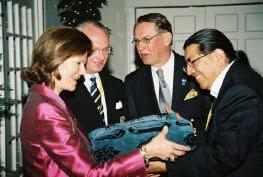
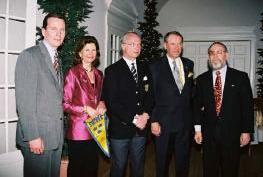
13
Familiarization Tours
The International Office is called upon to present economic summaries, industry overviews and business briefings to international government officials, business representatives and the media.
International Website
Resources, market information, services and connections for Utah businesses and foreign investors can be found on the International Office’s website that is maintained and updated regularly.
Relocation Assistance
Ongoing assistance is provided to international companies that are relocating to Utah.
Certificates of Free Sale
During the 2001-2002 fiscal year, the International Business Development Office produced and notarized more than 3,200 Certificates of Free Sale for foreign governments on behalf of Utah companies. Many countries require the certificates for Utah exports to enter their country.
Government Executive Exchange Program
Utah participates in a government executive exchange program with the Japanese provinceof Gifu. The International Office provides office space and support and benefits from an increase in resources, awareness and communication with Japan. The office is arranging to welcome an additional government executive from Korea in the coming year.
InternationalPartnerships
Throughout the year, many partnerships were formed to maximize the work of the International Office and expand its reach. Partnerships included Utah chambers of commerce, Ski Utah, U.S. Department of Commerce, World Trade Association, International Visitor’s Program, Downtown Alliance, city and county economic development offices, Salt Lake Olympic Committee (SLOC), United States Olympic Committee (USOC), District Export Council, Utah Honorary Consuls, Foreign Consulates, and international programs at Utah colleges and universities.
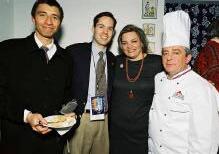

14

Mission
National Business Development
The mission of the National Business Development program is to create high-paying jobs in Utah by recruiting new or expanding companies to the state.
Accomplishments
National Business Development was heavily involved in activities related to the 2002 Olympic Winter Games. Prior to the games, National staff members hosted a number of groups at Olympic Venue Tours. Staff invited companies or conference participants visiting Utah to tour Olympic venues and to begin thinking about how they could participate in the games.
During the games, staff members were involved in hosting clients during the Wave programs and atthe Devereaux Business Club. The Wave program included a number of national and international guests representing companies, site selectors and venture capital firms. National staff also spent a considerable amount of time at the Devereaux Business Club hosting Utah companies and their clients.
Another major event that occurred in Utah this year was the first ever CoreNet Global Summit. Over 2,000 corporate real estate executives came to Salt Lake for a five-day conference. The state of Utah, in partnership with the states of Idaho and Wyoming, and a number of local sponsors hosted a private dinner for selected attendees. We also sponsored an opening night gala at the Utah Olympic Oval in Kearns. The Summit was a great opportunity to showcase the state to these corporate real estate executives. The last time this conference came to Utah was in l983.
15

Mission
Metro Business Development Procurement Assistance
Maintaining a successful business is a challenging endeavor. The Procurement Technical Assistance Center serves Utah’s small business owners by providing the technical assistance and resources required to successfully compete for government contracts.
Highlights
Economic Impact: In Fiscal Year 02, the Procurement Technical Assistance Center assisted Utah businesses that were awarded 940 federal, state, and local government contracts that had a value in excess of $220 million. These contracts had an overall impact equating to 5,500 jobs established or retained, based on analysis conducted by University of Utah Bureau of Economic Research that indicated $1,000,000 in government contracts equates to 25 jobs either established orretained.
Diversity of Service: The Center maintains a client base of approximately 800 businesses statewide. From construction firms to manufacturing companies to service firms, the Center serves business owners from a broadspectrum of industry sectors. Clients may access current bidding opportunities, manufacturing specifications and standards, historical pricing data, and other resources. These resources are provided to clients to improve their competitive advantage in bidding and acquiring government contracts.
Business Training: Center staff participated in 35 conferences and training seminarsthat provided government contracting information to more than 1,200 business people.
Aerospace Trade Show: The Center sponsored a booth at the Paris Aerospace Trade Show, which is recognized as the world’s most prominent trade show for aerospace related companies. The Center booth sponsorship provided the opportunity for three Utah companies to participate in the trade show at an affordable cost. Additionally, Center staff assisted companies to facilitate networking and marketing opportunities with major aerospace industry representatives.
Utah Supplier Showcase: As a member of the Utah Supplier Development Council, the Procurement Technical Assistance Center participated in the May, 2002 Supplier Showcase held at the Rice-Eccles facility on the University of Utah campus. The Showcase was an opportunity for Utah’s small businesses to network and develop business relationships with over 400 buyers from large businesses and government agencies.
16

Rural Development
NEW PROGRAM
The Rural Development Program was formed in May of 2002 under the Division of Business and Economic Development. The New Rural Development Program combined the forces of the already existing Rural Business Development program and the highly successful Governor’s Smart Site Initiative formed just one year earlier.
MISSION STATEMENT
Rural Development will foster business growth by promoting existing business in Rural Utah to grow and expand. We will continue to expand the Governor’s Smart Site Initiative and explore new opportunities for business growth in Rural Utah.
HIGHLIGHTS
Utah Smart Site Initiative: Governor Leavitt – “I predict that by the time our 1,000 day plan has run its course that, within the Smart Sites collectively, wewill have the largest single employment source in rural Utah.”
Utah Smart Sites were first funded on July 1, 2001. Within the first year, 450 new jobs have been created by technology-based businesses that have started, expanded, or located in the 15 rural counties that have earned Smart Site status.
Through a USDA Rural Development grant, a consultant is working with interested Utah’s Indian tribes to create American Indian Smart Sites.
The Utah Smart Site program hosted over 500 guests during a Salt Lake Olympic Winter Games. Events began with hosting business dignitaries at Delicate Arch to welcome the Olympic Flame and ended with a series of dinners at the Utah Business Club at the Devereaux adjacent to the Olympic Medals Plaza.
17
Small Business Development Center (SBDC): Utah SBDC’s is a partnership between the State of Utah, Utah Rural Development, Small Business Administration and local Utah colleges and universities. This partnership resulted in:
2,512 Utah business owners counseled
10,690 hours spent counseling Utah businesses
368 Business Seminars with 6,824 attendees
12 SBDC Centers available statewide
Enterprise Zone and Recycling Zone Administration: Enterprise Zones and Recycling Zones offer tax credits for job creation and investment in plant and equipment by business located within their designated area. 107 Rural businesses earned over $750,000 in tax credits from Utah Enterprise Zones and Recycling Market Development Zones. These credits were earned as a result of over $7.5 million dollars in investments in plants and equipment made in rural Utah.
Pioneer Communities / Main Street Program Administration and Heritage Development:
Main Street Program
Utah Pioneer Communities / Main Street provides hands-on training and guidance in economic development, streetscape design, architecture, marketing and organizational development aimed at enhancing downtown’s appearance, strengthening its business environment, effectively marketing it and building community pride.
A total of 19 Utah communities have received services this past year from the Main Street Program. 13 grants were awarded for rehabilitation of historic commercial buildings to property owners in 10 communities statewide. We have administered the ongoing Utah Heritage Highway contract to provide Heritage tourism in rural Utah along Highway89.

18

Mission
Industrial Assistance Fund
The Utah Industrial Assistance Fund is a $10 million post-performance disbursement created by the Utah State Legislature in 1991 to provide grants in the establishment, relocation, or development of industry in Utah.
Highlights
Fiscal year 2002 was a productive year for the Industrial Assistance Fund. With 15 companies funded there were 2,964 jobs created. This was 181 percent of the median county wage. Using $6,761,000 of fund money, $93,282,000 of potential new tax dollars are estimated. This maintained 12 times the return on taxpayer dollars.
There are three incentive programs within the Industrial Assistance Fund. Disbursements are made to qualifying companies in one of the three following areas:
Rural Incentive Program Rural Loans are available to companies that are relocating or expanding outside Davis, Weber, Salt Lake, and Utah Counties. The Division of Business and Economic Development (DBED) Board IAF Committee approved nine Rural incentives in the 2002 Fiscal year.
Targeted Industry Incentive Program Targeted Industry Incentives are available to qualified companies that are relocating or expanding with in one of the urban counties. Qualified companies must also operate with in one or more of the industries identified are targets each year by the Division of Business and Economic Development Board. Targeted industries are Bio-med, Finance, High Tech, Aerospace or Corporate Headquarters. The DBED Board IAF Committee approved six Targeted Industry incentives in FY 2002.
19
Corporate Incentive Program
Corporate disbursements are available to qualified companies that are relocating or expanding inside Davis, Weber, Salt Lake, and Utah counties. These disbursements are reserved for extraordinary growth that involved heavy capital investment, large numbers of new jobs, and a high average salary. There companies must also meet high requirements of Utah purchases during the term of the loan. No Corporate Incentives were approved this year.
Earned Credits
Participating companies earn disbursements from the state through performance credits. Each year after a company has met the employment and economic activity goals as set forth in the IAF Agreement, the annual payment is disbursed according to verified reports of performance. The IAF Agreement is currently available online at www. nxlight.net/dced password “anyuser” username “anyuser.”
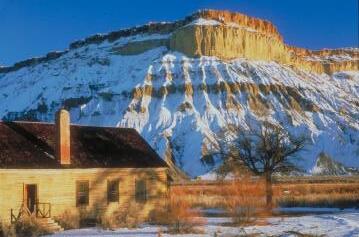
20

Utah Film Commission
http://film.utah.gov/
The Utah Film Commission released its 2001/2002 fiscal year-end numbers and reported the motion picture industry and Olympic filming activities added $141.6 million dollars to state coffers last year. That figure is up from the 2000/2001 mark of $117 million.
Productions include: 12 feature films-New Line's most recent blockbuster Austin Power In Goldmember and Paramount's soon to be released, The Core; Utah's on-location regular series Touched By An Angel; five made-for-television movies or episodes of network series, including PAX-TV's It's A Miracle, and NBC's Today Show; and 111 commercials, print ads, documentaries, and music videos that were shot on location in the Beehive State.
Production for this year is getting off to a good start as well. Big studio projects like Universal's The Hulk have utilized Utah locations earlier this summer and will do so again this fall. Annaugh Productions is back filming a second feature in Utah and Juab Counties that will be aired on Showtime, and Utah is the only state outside of production centers New York and Los Angeles to be hosting two network television series on-location; CBS-TV's Touched By An Angel is back for its ninth season and the WB's series Everwood will be debuting this fall.
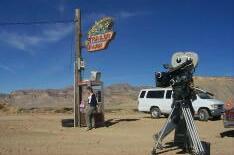
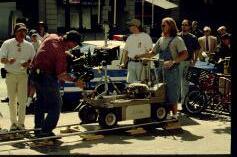
21

Greetings,
Division of Travel Development
Utah Travel Council
http://dced.utah.gov/travel/
For the Division of Travel Development, the Olympic Winter Games dominated FY02. Efforts began early to take advantage of the curiosity and interest in the state that was generated by Utah’s host status. A high level of interest on the part ofthe media worldwide required a record number of facilitated interactions. During the games, operation of the Utah Media Center involved division employees plus more than 200 volunteers. But following the games, the Division began what may be the most important task of the Olympic era; the effort to take advantage of Olympic attention and converting interest in the state into actual visits able to positively affect the state’s economic bottom line.
Careful study of the experiences of past Olympic venues has made it clear that in order to reap positive economic growth, strong follow-up efforts must be undertaken. The state of Utah cannot sit back and wait for an Olympic “paycheck.” In order to truly profit from the Olympic experience, additional investment is required to advertise the state and entice the visitors who generate funds that are critical to Utah’s economic development.
Immediately following the Olympic Games, the Division began the work of following its own 1000-Day Plan, which dovetails with the Governor’s plan. These programs continue and will guide our efforts in FY03 as we strive to advocate for more financialinvestment in tourism, one of the state’s most successful economic growth industries.
Sincerely,
Dean Reeder Director
22
THE DIVISION OF TRAVEL DEVELOPMENT EXISTS TO MAKE UTAH A BETTER PLACE TO LIVE BY INCREASING THE ECONOMIC CONTRIBUTION OF TOURISM.
During FY02, the Division’s mission statement was challenged and tested during preparation for the 2002 Olympic Winter Games, during the Games`, and in efforts shaped by the Governor’s 1000 Day Plan following the Olympics. The events and activities of FY 02 shaped many of the goals for FY 03 as the Division strives to take advantage of the awareness of the state that came as a product of the Olympic Winter Games.
FY02 reaffirmed tourism as a vital economic force and a revenue-generator for the state. In 2001, Utah attracted 17.3 million non-resident visitors who spent $4.15 billion. The tourism industry generated $340 million in tax revenues last year. And travel and tourism-related employment continues to grow, totaling 128,500 jobs in areas across the state.
The 2002 Olympic Winter Games
Olympic Coverage
Coverage of the 2002 Games put Salt Lake City, Utah on the global map. The International Olympic Committee reports that the Salt Lake 2002 broadcast was the most successful in Olympic Winter Games history – 2.1 billion viewers in 160 countries watched the Winter Olympics. Levels of television viewing were particularly high in the U.S., Canada, Germany and the Scandinavian countries. Extended news and feature coverage related to the Games meant a total of nearly 3 billion people around the world were exposed to media coverage of the 2002 Olympic Winter Games.
Print coverage of Utah appeared in thousands of newspapers and magazines around the world during the 2002 Olympic Winter Games. The value of just tourism coverage alone during February in major U.S. publications totaled $22,943,976. (That conservative valuation is based on the advertising rates charged for comparable column inches. It does not include the tens of thousands of other stories focusing on the Games themselves.)
Broadcast coverage of the Games reached a total audience of 187 million viewers with an average rating of 19.2 (149% above regular network programming).
Before and during the Games, tourism-related articles about Utah were published in USA Today, the New York Times, the Los Angeles Times,the Wall Street Journal and metropolitan dailies throughout the United States and Canada. Articles about tourism in Utah appeared in such magazines as Newsweek, Travel Holiday, Travel & Leisure, Sunset, National Geographic Traveler, National Geographic Adventure and National Geographic magazine. Coverage of travelin Utah was also featured in top newspapers, magazines and Internet sites in Europe and Asia.
Utah Media Center
The Utah Media Center (“UMC”) was designed to provide a valuable and needed service to members of the working press who would be attending the Games, but who would not have the credentials necessary to be allowed into the actual venues and events, and would therefore be looking for other kinds of stories to file. At the same time the UMC met the objectives of the Utah Travel Council to promote the “Utah!” brand of travel and tourism by capitalizing on a captive audience of reporters, broadcasters and others. It also drew members of the press who held SLOC credentials for press conferences, and athlete interviews.
Nearly every staff member of Travel Development worked at or on some aspect of UMC, many of them full time for several months. The UMC also had the support of many other media and tourism professionals and volunteers.
23
The measure of UMC’s success varies according to objective and subjective points of view, but the net is highly favorable. From a purely fiscal standpoint which does not include figures for the value of news stories, articles, general publicity and goodwill worth hundreds of thousands, even millions of dollars, derived by the State, the center delivered revenues slightly below its costs, using approximately $100,000 of the funds originally appropriated by the legislature. When a value is placed upon those less tangible elements, however, the balance quickly shifts far into the black.
Subjectively, the UMC was a great success by nearly all accounts. Network clients glowed in their praise of our operation, as didthe general media, dignitaries and athletes who visited the center over the course of the Games. Sponsors were positive, and most expressed that they were glad they participated and expect good long-term benefits to their organizations.
The final outcome, of course, will be measured over the course of years, in terms of increased tourism visits, revenues and media publicity, as well as increased business and economic development outside of tourism, but the Utah Media Center was a success in which the State of Utah, Department of Community and Economic Development and the Division of Travel Development can take great pride and satisfaction.
Some final Media Center statistics:
Total expenditures - $458,226.27
Total revenues - $476,982.81
Staff - 18
Volunteers - 259
Media – 1,973
Sponsors - 26
News events hosted - 82



24
Olympic Research
The 2002 Olympic Winter Games: Impact, Images and Legacies report summarizes the Olympics-related research conducted throughout the planning stages of hosting the 2002 Games, including economic impact research, ski industry impacts, pre-Olympic measurements of image and awareness in key international markets, and key infrastructure developments.
Marketing Observations from Previous Olympic Host Communities documents the efforts and results of previous Olympic host communities in leveraging the Games for future economic growth.
The 2002 Olympic Tourism Reference Sheet provides a two-page summary of the most important Olympic and Utah tourism statistics.
During the Games, the 2002 Olympic Winter Games Highlights summarized news stories each week from sources across the country to document major themes such as business trends, television ratings, security, and volunteers. A two-part project, the Pre- and Post-Olympic Domestic Awareness & Image Study identifies the changes in consumer perceptions of Utah as a result of the 2002 Olympic Winter Games. It documents Utah’s improved image as a result of hosting the Games and suggests further initiatives to leverage the Olympics for future gains.
In a collection of focus groups, the Post-Olympic Qualitative Research identifies the key emotional attachments between the 2002 Olympic Winter Games, Utah and Salt Lake City. The unique strengths of friendliness, success, and emotion (especially the “aspire and inspire” themes) can be utilized in future communications efforts.
Advertising
Utah Travel Council
Fiscal Year 2002 Media
The following describes the media that was placed for the Utah Travel Council in FY ’02:
Fall 2001 Branding Campaign
Television:
Portland:
800 TRPs
3 weeks total (2 on, 1 off, 1 on)
October 29 – November 24, 2001
84% Reach, 9.5x Frequency
San Francisco:
800 TRPs
3 weeks total(2 on, 1 off, 1 on)
October 29 – November 24, 2001
80% Reach, 10x Frequency
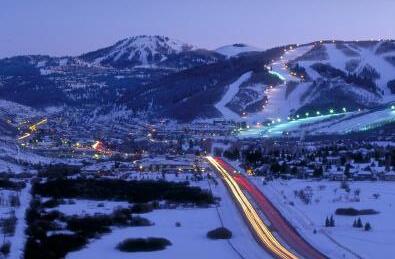
25
Metro Traffic Radio:
Portland:
200 :10 Spots, 101 TRPs, 29 stations
4 Weeks (2 weeks heavy, 1 light, 2 heavy)
November 5 – December 8, 2001
84.3 Reach
4.8x Frequency
San Francisco:
200 :10 Spots, 68 TRPs, 76 stations
4 Weeks (2 weeks heavy, 1 light, 2 heavy)
November 5 – December 8, 2001
59.3% Reach
4.6x Frequency
LosAngeles:
200: 10 Spots, 317 TRPs, 89 stations
5 Weeks (2 weeks heavy, 1 light, 2 heavy, 1 light, 1 heavy)
November 5 – December 22, 2001
77.3% Reach
4.1x Frequency
Magazines:
Gourmet – Co-Branding with Bank of America
Travel Holiday – Co-Branding with Kodak
Outside
Outdoor Photographer – Co-Branding with Petzel
Hooked on Outdoors – Co-Branding with Zeal Optics
Internet: AMI Group
Gorp.com
The Away Network NYTimes.com
Fall 2001 Promotional Campaign
Utah’s $20.02 Winter Celebration
September 2001 – April 2002
Magazines: Ski Skiing Powder
Warren Miller’s SnoWorld Travel & Leisure
Direct Mail: Dropped November 7, 2001

26
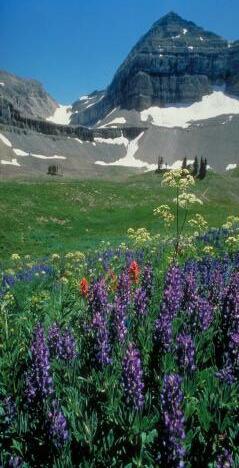
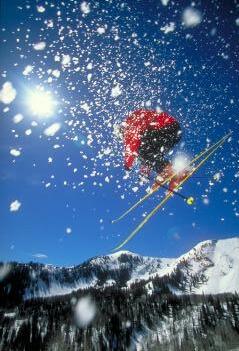
27 Winter 2002 Branding TV: February 18 – 24,2002 NBC Television: San Francisco: 133 TRPs, 16 spots 71% Reach 1.9x Frequency 2,324,000 Audience LosAngeles: 56 TRPs, 8 spots 42% Reach 1.3x Frequency 3,063,000 Audience San Diego: 55.2 TRPs, 6 spots 45% Reach 1.3x Frequency 570,000 Audience Salt Lake City: 21 TRPs, 1 spot 21% Reach 1.0x Frequency 183,000 Audience Spring 2002 Branding TV Academy Awards & 2 weeks Early and Late News March24 – April 7, 2002 LosAngeles: 1 spot Academy Awards 2 weeks Early and Late News – 140 GRPs San Francisco: 1 spot Academy Awards 2 weeks Early and Late News – 140 GRPs San Diego: 1 spot Academy Awards 2 weeks Early and Late News – 140 GRPs Las Vegas: 1 spot Academy Awards 2 weeks Early and Late News – 140 GRPs Seattle: 1 spot Academy Awards 2 weeks Early and Late News – 167 GRPs
Dallas: 1 spot Academy Awards
2 weeks Early and Late News – 140 GRPs
Portland: 1 spot Academy Awards
Spring/Summer Campaign
Branding + 20.02% Celebration
March - July 2002
Magazines: Travel Holiday
Conde Nast Traveler- Co-Branding with New Balance
Sunset Westways
Gourmet
Internet: Trails.com
Gorp.com
Outsideonline.com
Travelandleisure.com
Direct Mail
Dropped March 25, 2002
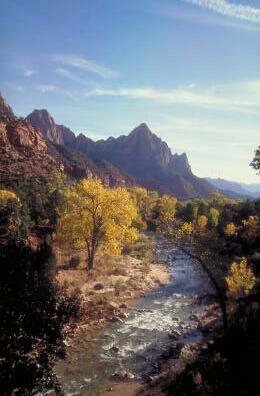
National/International Public Relations and Trade Development
The Division conducted a global public relations program in North America and in key European markets in the 12 months before the 2002 Olympic Winter Games. The program, conducted with public relations firm Hill and Knowlton, generated 109,940,565 national impressions to increase awareness of Utah. The national and international plan included: monthly tourism news releases; seven group familiarization tours; dozens of individual press trips to Utah; planning and execution of the $20.02 Winter Celebration media event in New York City with Ski Utah; Olympic Torch Relay outreach to media throughout the United States; and an ongoing news bureau. The Division also developed an online newsroom for travel journalists on its state website to facilitate dissemination of story ideas about tourism in Utah.
Broadcast coverage of Utah destinations appeared on top television networks in North America and overseas, including NBC, the BBC, CNN, CBC and NHK.
The Division’s video B-roll and 2002 Gold Edition Photo CD were successful initiatives. Many of the CD’s 84 high-resolution images of Utah’s Olympic venues, tourism destinations, national parks and other unique landscapes appeared in hundreds of magazine and newspaper articles around the world and on dozens of websites. The Division distributed 2,600 of the Photo CDs to media and tour operators in FY2002. We also distributed 48 video B-roll tapes to broadcast media for use in television coverage of Utah.
The Division’s international marketing outreach targeted National Olympic Committee-designated tour companies in 46 countries– providing them with information and images for Utah product in tour catalogues and for trip packages to Utah during the Games.
The Division provided Utah tourism and Salt Lake Olympic publications for distribution by U.S. embassies in the U.K., Belgium, France, Germany, Finland, Italy, Portugal, Spain and Hungary.
28
The Division represented Utah at three major travel trade shows in the U.S., UK and Germany resulting in more than 200 tour operator leads. Eighty travel-trade media were also contacted during trade shows and allied events. The Division worked with many National Olympic Committee-designated tour companies to include Utah in their catalogues and trip packages.
The Division’s Japan market representative attended four major trade shows in Japan and the U.S. and conducted 52 destination development seminars for Japanese tour companies and travel agents in the U.S. and in Japan. Fieldstar International also worked extensively with Japanese media covering stories about Utah before and during the 2002 Olympic Winter Games; maintained a Japanese-language travel website; published the annual travel magazine W’est with a targeted circulation of 120,000 in Japan; and worked with major Japanese tour operators to promote travel to Utah’s national parks and to Salt Lake City.
As part of the Division’s 1,000 Day Plan, we established the framework to convert post-Olympic awareness of Utah into increased visitation. That framework includes travel trade missions, media outreach and spot projects to be conducted in FY 2003.
The Division’s plan has been designed to work in conjunction with the Governor’s 1,000-Day Plan, including participation in some of the Utah! Trade Missions to leverage synergies with the state’s business development strategy.
Extensive post-Olympic analysis identified the United States, particularly the western half of the country, as having the largest and most immediate potential for increased visitation to Utah in the wake of the Olympic Winter Games. A Wirthlin Worldwide spring 2002 national survey indicated that more than seven million American adults are more likely to vacation in Utah as a result of watching the Winter Olympics.
Post-Games public relations efforts in North America complemented the Division’s post-Olympic advertising campaign and will continue to do so in FY 2003.
Post-Games, the Division established three target tiers for international markets:
1. The top tier includes Canada, the U.K., German-speaking nations (Germany, Austria and Switzerland) and Japan.
2. The second tier includes France, Italy, Belgium and the Netherlands.
3. Olympic Follow-Up Markets include Scandinavia, Korea, Spain and Mexico.
Publications
In-State Programs
The 2002 Utah! Olympic Scenic Calendar (the 29th annual edition) was another award winner. It won a Bronze Award for Best Design in the Calendar Marketing Association National Competition. The 40,000 copies of the special Olympic edition featured an Olympic torch superimposed over the cover photograph aswell as each month’s calendar in a gold-like metallic ink. The 13 full-color scenic photos and seven inset photos of Utah’s scenic wonders were, as always, the mainstay of the calendar.
The theme for the 2002-03 Utah Travel Guide was “The Fine Art of Travel” using original artwork of Utah’s famous recreation areas creating a two-phased, 96-page guide. Half of the planned 400,000 copies printed were “2002 Olympic” editions with a special Olympic Winter Games insert, and the other half (200,000) were printed without the Olympic reference for usethrough 2003.
29
The Utah Accommodations Guide is a separate companion brochure to the Utah Travel Guide. The Utah Hotel & Lodging Association in partnership with the Utah Travel Council produces it annually. Banta Printing printed both guides through state Purchasing’s competitive bid process.
Thousands of photographs were reviewed from the state’s and country’s best professional photographers for use in the Photo Library. The Library provides photos for all division publications, media (over 2,000 this year) and other non-profit organizations for promoting Utah tourism.
Communications
Weekly radio reports on 16 stations around the state provided listeners with the latest Utah travel and tourism news and events.
Six division Update! newsletters were produced in FY02, and three comprehensive calendars of events - the 2002 Major Annual Events List with a total of 104 events, the 2002 Reference List with more than 600 events, and the Weekly Calendar distributed every Friday to Division Board Members and staff, recreation therapists, state public information (PIO) officers, tourism and county offices, etc. (a total of 229 people). The events calendars are available on the Internet at:http://www.utah.org/travel/Major_Events_2002.pdf
http://www.utah.org/travel/2002_Reference_List.pdf
http://www.utah.com
Call Center
The UTC Call Center completed its second full year of operation located at Council Hall. With availability for three full time equivalent employees as authorized by the Legislature, we have live operators on duty MondayFriday 8:00 a.m.–5:00 p.m. Callers to our three toll-free lines and the Utah local line regularly express appreciation for the opportunity to speak to a real person and not just a recording. After hours we also provide recorded information and allow callers to leave a name and address for materials to be mailed.
We handled 42,908 calls (31,677 live, 11,231 recorded) in FY02 from mainly the United States and Canada but also from many other countries. Our cost of operation of the Call Center is down to around $75,000/year compared to the last full year of out-sourced (UCI) operation at $105,000.
Distribution
Our distribution office handles the packaging and mailing of Utah travel and tourism publications, primarily the Utah Travel Guide, Utah Accommodations Guide and Utah Highway map. We also distribute as requested other travel publications such as the Utah Ski Guide, Outdoor Utah Guide, and otherfederal, city, county and region publications.
In FY02 we mailed 51,419 packets of information to those who requested materials via the mail, the Call Center and 19,184 Internet requests. In addition to individual mailings, we also distributed materials in bulk to Welcome Centers, AAA offices, chambers of commerce, libraries, travel agents and trade shows.
Utah Travel Guides distributed in FY02 totaled 396,000, including the bulk shipments from the printer in January of the Olympic Edition, many of which are still in stock and being distributed.
Our office assists the Utah Department of Transportation (UDOT) in the distribution of highway maps used for tourism purposes. We and UDOT distributed 560,000 highway maps in FY02 of which many are still in stock and being used.
30
Internet
The utah.com web site received 3,746,155 hits during the fiscal year, and continued to be the medium of response targeted in advertising campaigns. The site was continually monitored and changes and additions were conducted in a constant evaluation cycle.
The internet continued to be an important method of conveying information about Utah through both utah.com and our government site utah.org/travel which includes general information about the division and research materials relevant to the travel and tourism industry.
Interagency Development
Scenic Byways
Two new state scenic byways were created:
Legacy Parkway
Dead Horse Mesa (Hwy 191 near Moab)
Three new national Scenic Byways were designated: Highway 12 as All-American Road
Dinosaur Diamond as a National Scenic Byway
Logan Canyon as a National Scenic Byway

Four federal project grants awarded were awarded to Utah from FHWA:
Energy Loop - $25,564 (for administrating a National Byway)
Energy Loop $11,120 (for interpretive signage)
Nebo Loop $25,000 (for administrating a National Byway)
Provo Canyon $774, 022 (for non-motorized trail extension)
Total: $835,706
Matching Funds
One multi-region and eight Travel Regions submitted a total of 20 applications of which 18 applications were approved for funding.
Total amount requested:$188,225
Total amount approved: $169,375
Welcome Centers:
Five gateway welcome centers received $56,000 each for administrative and operations. $1,000 at each center is dedicated to computer costs. UDOT completed a new maintenance contract that seems to working well.
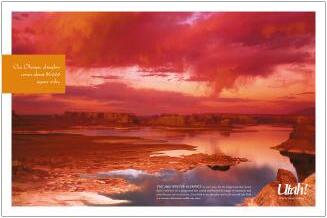
31
Research and Planning Program
In addition to the Olympic-related research documents mentioned at the beginning of this report, several other research-related reports and documents were prepared and distributed during FY02:
Research Series Publications
The annual edition of the Tourism, Travel & Recreation Chapter in the 2002 Economic Report to the Governor illustrates the industry’s 2001 performance and presents the 2002 outlook.
The annual edition of the State & County Economic and Travel Indicator Profiles serves as Utah’s most comprehensive statistical report on the state’s tourism industry. The report includes state and county data on traveler spending, emp loyment, tax revenues, land ownership, and regional visitation statistics.
The 2002 Market Profile Analysis complements the Division’s marketing plan, providing a situation analysis, including a discussion of Utah’s tourism industry, domestic and international visitors, consumer trends, and main competitors.
Complementing the Division’s trade development and public relations plan, Welcome the World: An Evaluation of International Tourism Markets includes detailed analysis of several international markets, providing a guide to prioritize and evaluate outreach initiatives in each market.
Ad Hoc Research, and Planning Publications
Throughout September and October, a Post September 11th Risk Analysis provided weekly updates to keep Utah tourism industry partners informed about the situation of the travel and tourism industry and the impacts the events would likely have on the state’s tourism economy.
A year-long evaluation of the Division’s advertising program, the 2001 Utah Advertising Impact Study documented the success of the 2001 campaign in raising awareness of Utah advertising in every market tested and highlighted the exciting success of spot market television advertising in Portland, Oregon.
The 2002 State & County Restaurant Survey provides a snapshot of the relative value of travelers to Utah’s restaurant industry.
Three issues of the Utah Travel Barometer, a research and planning newsletter were published during FY02. This quarterly publication features timely research and industry trends. Each issue is distributed to over 1,500 tourismrelated constituents and businesses and government entities. In addition, the publication is available on-line at www.utah.org/travel.
The division’s strategic plan was under evaluation during the latter part of FY02 in preparation for a FY03 update.

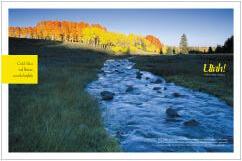
32

Division of Community Development
http://dced.utah.gov/community/community.html
“Hard choices are hard because they are between two things you’ve been telling the world you believe in equally,” says Marty Linsky, professor at Harvard University’s Kennedy School of Government Program for Senior Executives in State and Local Government. One of my classmates at last June’s session was Maurice Kemp, a lean man so tall he must approach seven feet.
Maurice argued there is a “moral compass” in favor of civility that is of equal weight to other values in making choices.
Linsky scoffed at that. “What do you want written on your tombstone, Maurice? ’Here’s Maurice; he never yelled at anybody?’”
“No,” Maurice answered, “They’d say, ‘we cut off his legs so he’d fit and here he is.’”
Another instructor, Dan Fenn, summed up hard choices in a story about Bert and Matilda. They went to the fair for their thirty-fifth wedding anniversary and saw the world’s biggest pumpkin, the most distorted squash, and the fattest pig. They just had a wonderful day and, only reluctantly, hooked up the horse and buggy to head home. On their way, they saw a biplane parked in a field. Nearby was a sign offering a ride over the county for ten dollars. A pilot was standing by a tree in a leather hat and leather jacket, ready to take off.
33
Matilda insisted they stop because she thought the airplane flight would just be the perfect way to cap off the perfect day. Bert was skeptical: “Matilda, ten dollars is ten dollars.”
“Well, couldn’t we fly over the farm and claim it as a business deduction?”
“Matilda, ten dollars is ten dollars.”
This went back and forth and finally the pilot said, “I’ll tell you what I’ll do. I’ll take you up and if neither one of you says a word, the flight is on me.”
They thought about it and agreed. So they climbed in the back seat and the pilot took them up. He flew all over the county, up and down, loop-de-loops, figure eights, and divebombed a few barns and not a word out of the back seat. Finally he landed and he said, “you’re the quietest couple I’ve ever flown. How did you do it?”
“Well,” Matilda said, “I almost said something when Bert fell out.”
After cutting budgets in the pre-legislative, regular, and special sessions of the Legislature this past year, I know the legislative and executive branch both feel like Matilda. “Ten dollars is ten dollars,” but we’d still like to have Bert.
“The most common form of stupidity is forgetting what we’re trying to do,” said Dutch Leonard, quoting Graham Allison, who was quoting Nietzsche. Dutch went on to parse this a bit, how the original German text was finally located for the quotation, and the actual word is not “do” but “intention,” we forget our intention. Question Zero for an organization, then is “what exactly are we trying to accomplish what is our intention?”
The budget challenges of the last year have focused us like never before. We’ve got to be clear about our intention in order to take the remaining resources and, working with our partners, accomplish the mission assigned us. What we’ve agreed to as managers of Community Development Division programs is to continue to provide and hopefully improve great customer service. We shall continue to work on that despite the budget restraints. We ask for your support and occasional indulgence as we move forward leaner but more focused than ever before on accomplishing the objectives assigned us.
Kerry William Bate, Director
34

Mission
State Community Services Office
The State Community Services Office strengthens communities by reducing poverty and improving the quality of life for low-income Utahns.
Highlights
The State Community Services Office (SCSO) provides funding, technical support, and leadership to support statewide efforts to create affordable housing, give refuge to the homeless and victims of domestic violence, feed the hungry, and provide home winter utility assistance.
SCSO is responsible for the administration of the following federal and state programs: Community Services Block Grant, Community Food and Nutrition Program, Low-Income Home Energy Assistance Program, Emergency Shelter Grant, Housing Opportunities for Persons With Aids, Shelter Plus Care, Critical Needs Housing, Homeless Trust Fund, and Emergency Food Network.
Services provided by SCSO and its community partners in the state include:
443 families were moved into transitional housing
1,400 households received emergency home repairs and disability access renovation
1,561 families received homeless prevention assistance
282,210 shelter nights were provided by homeless shelters
521,800 hot meals were fed to the homeless across the state
HUD Balance of State Continuum of Care
State Community Services Office coordinated the Balance of State Continuum of Care application. The Continuum of Care is a competitive grant offered through
35
the U.S. Department of Housing and Urban Development that requires coordination of homeless service providers to address the needs of the homeless population in our communities. Through the efforts of the SCSO, the low-income advocacy agency Utah Issues, and service providers who participated in the process, the state was able to secure $568,622 in additional federal funding for three separate agencies within the Balance ofState.
Iron County Care and Share: $35,073
Davis County Domestic Violence Shelter: $485,166
Bear River Association of Governments: $48,383
Homeless Trust Fund
In 2002, the Homeless Trust Fund “Change for a Dollar” Tax Check-off Campaign produced nearly double the amount of contributions made by the citizens of Utah year $191,000 as of June 2002. Advertising agency Humanize Interactive designed and developed the campaign’s billboards and public service announcements and KUTV-TV joined the campaign by broadcasting the announcements.
Outcome Measures
In 2001, the State Community Services Office implemented the Outcome Measurement Model for service providers receiving funding from the Homeless Trust Fund.
The Outcome Model provides a means for providers to track and measure the impact of the services they provide to Utah citizens by shifting the focus from the agency delivering the services to the customer receiving them. Agency services are analyzed at each step and adjustments are made to maximize the positive impact for the customer. The Outcome Model also provides valuable information that allows the State Community Services Office to report the impact of Homeless Trust Fund money to the Legislature and the public.
Innovative Community Programs
Ticket to Work
Disabled individuals in Utah were previously discouraged from working because their earned income would put them above the federal poverty level and disqualify them from receiving medical care paid for by Medicaid. The implementation of the Ticket to Work program now allows about 250 low-income, disabled Utahns who are can still work to find employment and escape poverty without sacrificing their medical care.
Food Pantries
Food Pantries, in cooperation with the Department of Workforce Services, provides a work/ learning environment for Emergency Work participants. The participants are required to work 32 hours each week and use the remaining 8 hours to do job searches. In northern Utah, the Bear River Association of Governments helps low-income families participating in
36
the DWS Family Employment Program attain and maintain full-time employment by providing families with cars for transportation to work.
“Deborah” was a young single mom raising a baby on her own and staying at the Domestic Violence Shelter. She had little or no employment skills, was unemployed, and had nowhere or no one else to turn to for help. With the coordinated efforts of several community agencies, she was able to get her own place to live and return to school. She also found full-time employment but had no transportation because her car needed repairs. With the help of Community Services Block Grant funds, the car received new tires and some minor repairs. “Deborah” now supports herself and her baby and faces a brighter future.
“Robert” worked for a company that went bankrupt and folded. He was drawing unemployment compensation and actively seeking other employment. But he exhausted his unemployment benefits before he could find a new job. He had no income to support his family and turned to one of our community agencies for help with his utility bills and mortgage payments. The agency was able to help him keep his home, keep it warm, and provide food for his family. He also received budget counseling and employment assistance. He finally found new employment and is back on track towards self-sufficiency with renewed hope.

37
HEAT Program
Mission
The Home Energy Assistance Target (HEAT) program provides winter utility payment assistance to low-income households, targeting those who are truly vulnerable, the lowest income households with the highest heating costs, the disabled, elderly, and families with preschool-age children. A warm home is as basic to health as good nutrition and medical care.
Highlights
“I am writing to express my appreciation for the Energy Assistance I received this season. I am a widow living on a $638 income. I am on a low-income housing list that may take up to two years. I have also filed for disability benefits. Obviously, after I pay rent, I have no money left for utilities. Again, thank you for your help.”
For the second consecutive year, a record number of Utah residents received help to pay their utility bills for home heating.
Fiscal year 2002 statistics for the federally funded Utah Home Energy Assistance Target (HEAT) program show that 32,031 low-income households in the state qualified for and were given financial assistant by the program to pay their bills for electricity, natural gas, and other fuels to keep warm last fall and winter. That is an increase of 740 homes from the previous year. The number of applications for assistance was also up during the HEAT program’s 2001-2002 season, which ran from November 2001 through April 2002.
In two years, the number of homes serviced by the HEAT program has increased by 6,333, or nearly 20 percent.
HEAT provides home winter utility payment and weatherization assistance to
38
low-income households, especially those with disabled and elderly residents and families with pre-school children. HEAT is administered in partnership with the states seven Association of Governments, Community Action Agencies, and other nonprofit agencies located throughout Utah.
HEAT is the Utah’s involvement in the Low-Income Home Energy Assistance Program. LIHEAP is a federal block-grant program and funded entirely with federal funds.
Other HEAT statistics for fiscal year 2002:
ß Utah’s HEAT program was funded by $12.2 million from the federal Low-Income Home Energy Assistance Program, down from $16.5 million the previous year.
ß The average household received $270 million in utility payment assistance, down from $390 in fiscal year 2001.
ß Sixty percent of aid recipients are on fixed incomes, 39 percent are disabled, 38 percent are considered the working poor, 24 percent are elderly, and 22 percent are families with preschool-age children.
ß Sixty-five percent of the HEAT-aided households are at no more than 75 percent of the federal poverty level and/or have incomes of $8,000 or less.
ß 1,122 households received emergency utility assistance.
ß 495 low-income homes were weatherized.
ß 312 households received crisis/furnace repair assistance.
39

Mission
Olene Walker Housing Loan Fund
The Olene Walker Housing Loan Fund is comprised of state and federal funds that assist in the construction, rehabilitation, and purchase of multi-family and single-family housing throughout Utah. The fund is named in honor of Lt. Governor Olene Walker in recognition of her lifetime advocacy of affordable housing opportunities for low to moderate-income individuals and families.
Highlights
Preservation – Preserving Valuable Affordable Housing
The Escalante Apartments in Salt Lake City were more than just a place to live for the many elderly residents who rent there. Many of them resided there more than ten years, and have built a community of neighbors. When they began receiving notifications that the project might no longer be maintained as a fully subsidized affordable multi-family project, it was a source of much concern and stress. “This is my home,” echoed many of the residents. “I want to stay here.”
Through the extraordinary efforts of Utah Non-Profit Housing Corp. and the Olene Walker Housing Loan Fund, this project was purchased by a non-profit affordable housing provider and completely rehabilitated to current standards. Utah Non-Profits Corporations commitment to long-term affordable housing assures that these units will be around for many years to come.
These units of affordable housing which were created nearly 30 years ago under the U.S. Department of Housing and Urban Development’s (HUD) Section 8 Affordable Housing Program. They are now at the end of their terms of contract with HUD. The owners of these projects now have the option to leave the affordable housing program and rent the units at prevailing market rates. When
40
owners choose to sell and allow the units to be updated and rented at market rates, many units of existing affordable housing canbe lost and existing tenants are often displaced. The Olene Walker Housing Loan Fund has pro-actively pursued solutions to this problem. A cohesive policy to protect such units has been implemented.
In fiscal year 2001, the OWHLF allocated $1.9 Million in funds for acquisition and rehabilitation of 541 units of existing affordable housing. These units were preserved at a cost of $42,000 per unit. The average cost for each unit of newly constructed affordable housing is more than double the cost of rehabilitated units.
Opportunities for Homeownership
The opportunity to own a home can seem to be an unattainable goal of many low to moderateincome persons throughout the Utah. Because of an expanding program developed through the OWHLF, many more people will achieve the goal of homeownership. The OWHLF has provided greater funding to local affordable housing agencies, working through regional Associations of Governments, to provide down payment and closing-cost assistance funds to low and moderate-income persons. In fact, the OWHLF participated in 260 down payment and closing cost assistance home purchases.
41
Average Project Project cost OWHLF funds Units funded Median Income
Escalante Apartments Salt Lake City $4 million $390,000 100 47% Holly Haven Apartments Clearfield $3.7 million $220,000 84 50% Stonehedge Apartments Layton $2.7 million $53,750 48 51% Village Square Apartments Ogden $3.8 million $200,000 101 47% Capital Villa Apartments Salt Lake City $4.1 million $300,000 108 60% USDA Rural Development Expiring Contracts Mercy Housing OWHLF funds Units Kaysville $800,000 100
The funds provided to the local agencies can help families find a quality, affordable mortgage on a home and local agencies can also help potential homebuyers avoid predatory lending practices. When OWHLF funds are involved in the transaction, the family is required to attend classes which outline the responsibilities of homeownership, including mortgage obligations, budgets, and maintenance, to assure successful home ownership.
Challenges
The Olene Walker Housing Loan Fund faces new challenges that affect low to moderateincome constituents. A growing number of working families are finding that the increased cost of living is limiting their opportunity for maintaining safe and affordable long-term housing. Housing providers across the country have seen the wait time for applicants seeking affordable rental units increase to an average of more than two years. The OWHLF staff and supporters must focus major efforts toward expanding funding sources, partnering with private banks, and finding creative ways to increase the number of constituents served.
42
Housing Opportunities for Persons with AIDS
Mission
Utah’s Housing Opportunities for Persons with AIDS (HOPWA) program is coordinated through the State HIV/AIDS Housing Steering Committee, which is a statewide body of housing advocates, providers, and consumers to facilitate the creation and maintenance of affordable quality housing opportunities for people living with HIV and AIDS.
The State of Utah received a HOPWA formula grant amount of $59,000 during fiscal year 2002. The state now administers the HOPWA Grant for rural Utah only.
A combination of the following activities are currently financed with state HOPWA funds: long-term rental assistance, emergency and short-term rental assistance to prevent homelessness, a statewide housing coordinator/resource developer, and resource identification.
The State HIV/AIDS House Steering Committee has been adopted by Division of Community Development as a subcommittee of the Olene Walker Housing Trust Fund board.
Highlights
Salt Lake Community Action Program (SLCAP): Spent $7,000 for 15 rural persons-with-AIDS households to provide short-term rental assistance and/or emergency assistance. Housing information, referrals, and placement services were also provided. SLCAP provides this assistance under the State’s HOPWA Program for rural areas south and east of Salt Lake County. SLCAP provides the same services for Davis, Salt Lake, and Utah counties under contract with Salt Lake City.
43
Housing Authority of the County of Salt Lake (HACSL): Spent $32,285 to provide long-term rental assistance for 10 housing units for PWA’s. The Housing Authority of Salt Lake City is now under HOPWA contract with Salt Lake City for the EMSA. The Housing Authority of Utah County is no longer a HOPWA provider due to the lack of need for such housing in the county.
Catholic Community Services-Ogden Area (CCS): Expended $19,537 to provide short-term rental and emergency assistance for 21 PWA households located in rural areas north of Salt Lake County. As with SLCAP, CCS also provides housing information, referrals, and placement services.
Kenyon Consulting, Inc.: Under contract with HOPWA to be its housing coordinator and resource development provider. Kenyon continues its effort to locate and develop housing-assistance resources and is working to identify and develop a housing project for PWA’s. The annual contract with Kenyon is $14,400.
St. George Housing Authority: SGHA was able to assist 2 PWA households with long term rental assistance and 4 households with short term/emergency assistance. Total expenses equaled $6,193.
Barriers and Trends
Although progress was made in rural northern and southwestern Utah, HOPWA still encounters difficulty providing access to and/or interest in services elsewhere in rural Utah. The general social/community climate in these areas sometimes inhibits persons with Aids from seeking services. They continue to travel to the Salt Lake City metropolitan area to access services.
HOPWA also encounters obstacles in identifying sponsors willing and able to develop and manage permanent housing. Although the Artspace Bridges Project was completed and provided 14 units for persons with AIDS, the goal in the Consolidated Plan to “develop at least fourteen housing units per year for persons with HIV/AIDS” is unrealistic and needs to be re-evaluated.
44
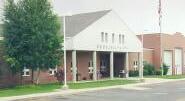
Mission
Permanent Community Impact Fund Board
The Permanent Community Impact Fund Board provides loans and/or grants to state agencies and subdivisions of the state which are, or may be, socially or economically impacted directly or indirectly by mineral resource development and appropriate process.
Highlights
A building to house the Uintah Basin Applied Technology Center in Vernal, the construction of a new fire station in Beaver County, a new library in Cedar City, and a recreation complex in Blanding. These are just a few of the infrastructure and other improvements in financially strapped rural communities made possible by the Permanent Community Impact Fund.
The Permanent Community Impact Fund Board approved loans and grants totaling more than $31 million for 76 local improvement projects in fiscal year 2002.
These projects range from street, water, and sewer system improvements to the construction of fire stations, town and city halls, and the purchase of equipment.
Each improvement made possible with the aid ofCommunity Impact Board funds makes rural communities more attractive places to live and enhances their efforts in attracting economic development.
Funding Sources
In order to help mitigate local impacts of major energy and mineral development on federal lands, the federal government returns half of the royalty revenues collected to the state of origin. The royalties collected are called mineral lease funds. Because of the extent of federal lands in Utah, these impacts are extensive.
45

Mission
Rural Development Fund
The Rural Development Fund Board provides grants to local government entities in south-central Utah impacted by the transfer of lands to the control of the Utah School and Institutional Trust Lands Administration by the federal government in 1998. The grants enable communities and agencies to finance local improvement projects to enhance the quality of life.
Statutory Authority
The Rural Development Fund (RDF) is a program of the State of Utah authorized in Section 9-14-101, et seq. The RDF provides grants to local governmental entities in south-central Utah impacted by the transfer of lands by the federal government in 1998 to the control of the Utah School and Institutional Trust Lands Administration. RDF funding is generated from a portion of mineral lease royalties collected on the exchanged lands.
Board Membership
The RDF is controlled by a five-member board comprised of a governor's designee and a mayor or county commissioner from each of the four participating counties Garfield, Kane, Piute and Wayne counties. Administrative and operational support is provided by the state Division of Community Development.
Eligible Applicants/Projects
"Eligible Applicants” are limited to county and municipal governments or special service districts within Garfield County, Kane, Piute County and Wayne counties.
The RDF board considers applications for capital projects.
46
Capital projects include public facilities, services, or infrastructure traditionally provided by local government entities under Utah statute. Eligibility is limited to projects owned by an eligible applicant.
Funding Guidelines
Applicants are strongly encouraged to leverage Rural Development Funds with other matching funds.
The RDF board will not fund planning or feasibility studies. Design projects which are directly related to and will result in a capital project will be funded on a equal cash match basis.
The RDF will not fund general operating budgets of eligible applicants. Additionally, the RDF will not fund operating or maintenance budgets for otherwise eligible projects.
All applicants must demonstrate that the facilities or services provided will be available to the general public and that the proposed funding assistance is not merely a device to pass along low interest government financing to the private sector.
Wes Curtis, Chairman, Governor’s Rural Partnership Commissioner W. Kay Blackwell, Piute County
Commissioner Joe Judd, Kane County
Mayor Sherwood Albrecht, Bicknell
Mayor Janet Oldham, Panguitch
47
Approved projects $1,099,602 Remaining Fund Balance $ 21,441
Project Category Approved funds Utility Improvements (electric, water, sewer, roads) $365,050 Public Safety (police, fire, sanitation) $125,050 Recreation / Cultural $334,502 Building Improvements (administration, medical) $275,000 Total $1,099,602 RDF Board Members Member
Fund Summary Revenues (FY-00 thru FY-02) $1,121,043
Approved Project Summary

Mission
Navajo Revitalization Fund Board
The Navajo Revitalization Fund maximizes the long-term benefits of state severance taxes paid on oil and natural gas production. Revenues from these taxes provide grants and/or loans to agencies of county or tribal governments in San Juan County which are impacted by the development ofoil and gas interests in Utah held in trust for the Navajo Nation and its members.
Highlights
Board Membership
The NRF is controlled by a five-member board composed of a governor's designee, two members of the San Juan County Commission whose districts include portions of the Navajo Reservation, the chair of the Navajo Utah Commission or his designee, and the chair of the Utah Dineh Committee or his designee. Administrative and operational support is provided by the state Division of Community Development.
Eligible Applicants
The NRF may authorize grants and/or loans to the Navajo Nation and its departments or divisions; any Utah Navajo Chapter, as defined in Section 63-88-101; the Navajo Utah Commission; Utah state agencies or subdivisions; the Navajo Trust Fund; or nonprofit corporation that are or may be socially or economically impacted, directly or indirectly, by mineral resource development.
Priority Projects
Capital projects and infrastructure, including electrical power, water, and other needed one-time projects.
Housing projects including purchase of new housing, constructionof new housing, or significant remodeling of existing housing.
Matching educational endowments that promote economic development and
48
Navajo culture, history, and language; and support postsecondary education opportunities for Navajo students.
thru FY-02)
John Harja, Chairman, Governor’s Office
Mr. Willie Greyeyes, Navajo Utah Commission
Mr. Roger Atcitty, Utah Dineh Committee
Commissioner Mark Maryboy, San Juan County
Commissioner Ty Lewis, Duchesne County
49
fund
706,702 Project Category Approved funds Housing Assistance $1,701,210 Utility Improvements $ 568,535 (Electric, water, sewer, roads) Public Safety (police, fire, sanitation) $ 361,314 (Police, fire, sanitation) Recreation / Cultural $ 122,175 Building Improvements $ 367,961 (Administration, medical) Planning $ 264,487 Equipment $ 84,665 TOTAL $3,470,347
Fund Summary Revenues (FY-98
$4,177,049 Previously approved projects $3,470,347 Remaining
balance $
NRF Board Members Member
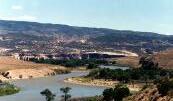
Mission
Uintah Basin
Revitalization Fund
The Uintah Basin Revitalization Fund assists Duchesne and Uintah counties and the Ute Indian Tribe with infrastructure impacts resulting from the development of oil and natural gas on Ute Tribal lands.
Statutory Authority
The Uintah Basin Revitalization Fund (UBRF) is a program of the State of Utah authorized in Section 9-10-101, et seq. The UBRF provides grants and/or loans to agencies of county or tribal government in the Uintah Basin which are impacted by the development of oil and gas interests held in trust for the Ute Indian Tribe of the Uintah and Ouray Reservation and its members.
Board Membership
The UBRF is controlled by a five-member board comprised of a governor's designee, a Duchesne County commissioner, a Uintah County commissioner, and two representatives of the Ute Indian Tribe's Business Committee. Administrative and operational support is provided by the Utah Division of Community Development.
Eligible Applicants
The UBRF Board may authorize grants and/or loans to agencies of Duchesne County, Uintah County or the Ute Indian Tribe that are or may be socially or economically impacted, directly or indirectly, by the development of oil and gas interests held in trust for the Ute Indian Tribe. Formal applications for UBRF grants and loans are submitted by the respective county commissions or the tribal Business Committee. All decisions of the UBRF Board require four affirmative votes.
50
Eligible Projects
Capital projects, including subsidized and low-income housing, and other one-time need projects and programs.
Projects and programs that are associated with the geographic area where the oil and gas are produced.
Prohibited Activities
Start-up or operational costs of private business ventures.
General operating budgets of Duchesne and Uintah counties or the Ute Indian Tribe.
Fund Summary
Revenues (FY-98 thru FY-02)
Approved Projects
Approved Project Summary
51
$3,634,471
$2,317,646 Balance $1,316,825
Education Facilities $1,243,227 Recreation / Cultural $ 344,704 Building Improvements (administration, medical) $ 729,715 Total $2,317,646
Rural Electronic Commerce & Communications System Fund
Mission
The Rural Electronic Commerce and Communications System Fund provides grants for programs or projects which preserve or promote communications systems in rural areas of Utah.
Statutory Authority
The Rural Electronic Commerce and Communications System Fund (REC) is a program of the State of Utah authorized in Section 9-15-101, et seq. The source of REC funding is a portion of mineral lease royalties collected on lands transferred by the federal government in 1998 to the control of the Utah School and Institutional Trust Lands Administration. The REC may also issue revenue bonds to provide financing for eligible projects.
Board Membership
The REC is controlled by a nine-member board comprised of a governor’s designee, a county commissioners from each of four rural counties, and four mayors from rural counties, with no more than two members from any single county. Administrative and operational support is provided by the state Division of Community Development.
Eligible Applicants
Entities concerned with preserving or promoting communications systems in Utah’s rural areas.
Eligible Projects
Programs or projects which preserve or promote communications systems in the
52
rural areas of the state.
Approved Projects
The $3.2 million upgrades to the statewide TV translator system will be financed with a revenue bond issued by a consortium headed by the Utah Association of Counties. In June 2000, the REC committed to provide an annualgrant equal to the annual debt repayment (including principal and interest) necessary to repay this debt over the eight-year term of the bond.
The payment requirements on this revenue bond area as follows:
53
Project
Approved
TV translator system upgrades $3.2 million
category
funds
Year Amount 2000 $ 81,805.54 2001 $169,243.50 2002 $285,703.50 2003 $539,590.75 2004 $538,658.00 2005 $537,327.00 2006 $537,466.00 2007 $535,876.00 2008 $535,188.00
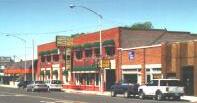
Pioneer Communities/ Main Street Mission
Utah Pioneer Communities/Main Street provides hands-on training and guidance in economic development, streetscape design, architecture, marketing, and organizational development aimed at enhancing the appearance of the downtown areas of Utah’s cities. Such improvements strengthen the business environment of those communities and boost community pride.
Highlights
Provided services to seven Main Street Partner communities: American Fork, Helper, Mt. Pleasant, Panguitch, Payson, Richfield, and Roosevelt.
Major projects include:
Development of streetscape concepts for Helper and Payson.
Completion of downtown market analyses for American Fork, Panguitch, Payson, and Roosevelt.
Development of a targeted marketing campaign for Panguitch.
Awarding of commercial rehabilitation grants to property owners in Panguitch, Payson, and Richfield.
Provided services to an additional 12 communities including: Downtown market analysis for Moab.
Downtown improvement planning for Grantsville.
Marketing/business growth workshops in Brigham City and Tremonton.
Organizational development (towards Main Street Partner) for Logan.
Thirteen grants were awarded for the rehabilitation of historic commercial buildings to property owners in 10 communities.
54

Community Development Block Grant
Mission
The Utah Community Development Block Grant program helps communities of fewer than 50,000 people provide a suitable living environment, decent housing, and expanding economic opportunities, principally for persons with low and moderate incomes.
Highlights
Fiscal year 2002 saw approximately $7.8 million distributed to rural Utah communities of fewer than 50,000 people thanks to the state CDBG program. The program continues to benefit cities and counties throughout the state.
In Utah, the CDBG program is unique because locally elected officials with input from local citizenry prioritize projects eligible for grants. The funds are distributed to the local Associations of Governments (AOG) as follows, with the number of projects in each region:
55
Agency Projects Grants Bear River Association of Governments 11 $1,181,460 Five County Association of Governments 2 $1,052,529 Mountainland Association of Governments 12 $1,399,213 Six County Association of Governments 6 $ 614,312 Southeastern Utah Association of Local Governments 7 $ 520,263 Uintah Basin Association of Governments 8 $ 460,536 Wasatch Front Association of Governments 28 $2,627,878 Total 74 $7,856,191
Similar to recent years, funding of community facility projects such as senior citizen facilities, homeless shelters, and children’s justice centers outpaced traditionally popular infrastructure projects such as water systems.
However, there has been a shift in the balance of funding to include affordable housing, Americans with Disabilities Act improvements for handicapped access, planning, sidewalks, curbs, gutters, and public services. Much of this can be credited to improved planning at the state and local levels.
56
0 5 10 15 20 25 % of Projects Community Facilities Water Planning/Econ. Dev. Housing Public Services Waste Water ADA Transport

Mission
Office of Museum Services
The Utah Office of Museum Services promotes museums and the essential role they play in our state as sources of community pride, centers of public education, and institutions that encourage economic development and tourism. The office assists Utah museums in improving their ability to care for and manage collections, develop quality educational resources, provide access to collections for research, and identify and successfully compete for financial resources.
Highlights
The Office of Museum Services collaborated with the Salt Lake Organizing Committee to sponsor the Cultural Olympiad on Tour before and during the 2002 Olympic Winter Games. Ten museums received grants to host an exhibit during the Games:
CEU Prehistoric Museum, Price Children’s Museum of Utah, Salt Lake City Collett Art Gallery, Ogden
Dan O’Laurie Canyon Country Museum, Moab Salt Lake City Public Library, Salt Lake City Heritage Museum of Layton, Layton Museum of the San Rafael, Castle Dale
Nora Eccles Harrison Museum of Art, Logan
A major responsibility of OMS is to help museums in Utah realize their public potential. In order to fulfill part of this responsibility, State Performance Goals have been established in an effort to raise the professional level of Utah’s museums. The following nine museums were certified by OMS for achieving State Performance Goals during FY 2002:
57
Anasazi State Park Museum, Boulder
Bountiful Art Center, Bountiful
Chase Home, Salt Lake City
CEU Prehistoric Museum, Price
John Wesley Powell Museum, Green River
Red Butte Gardens, Salt Lake City
Territorial State House Museum, Fillmore
Tracy Aviary, Salt Lake City
Wheeler Farm, Salt Lake City
Presented a workshop on photographic care and preservation. Authorities on photographic methods and supplies discussed early photography; black and white, color, and digital photography.
OMS joined with the Utah Humanities Council and other agencies to sponsor, Yesterday’s Tomorrows, a traveling exhibition of the Smithsonian Institute’s Museum. The exhibit examines how Americans of the past 100 years imagined their future and was shown at three locations: Hyrum City Museum, Washington City Historical Society, and the University of Utah Graduate School of Architecture.
Additional workshops included:
“A Traveling Roadshow” co-sponsored with the Utah Humanities Council. The workshop presented information and training on paper conservation and was held in Kanab, Green River, and Logan.
Collection Management and Computer Technology presented at the Utah Museums Association Annual Meeting in Wellsville.
OMS Grants
In addition to the programs and services listed above, $960,420 was funded for grants to 162 museums in 27 of the state’s counties. OMS also awarded $25,000 to the Utah Museums Association to help small museums attend the UMA Annual Conference and $12,500 to the Daughters of the Utah Pioneers to fund photography preservation
58
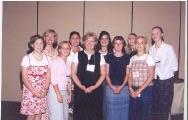
Mission
Utah Commission on Volunteers
The Utah Commission on Volunteers improves communities in the state through service and volunteering. Under the direction of Lt. Governor Olene Walker as chairperson, the commission builds the volunteer infrastructure of the state by administering AmeriCorps programs, overseeing America’s Promise efforts in Utah, and providing technical support and assistance to Utah’s Volunteer Centers, as well as training numerous nonprofit and community organizations throughout the state.
Highlights
AmeriCorps, which is part of the national call to service by President George W. Bush, consists of more than 40,000 Americans, including 800 Utahns, who have been engaged in intensive, results-driven service each year. Following the completion of their terms of service, each AmeriCorps member received education awards to help finance college or repay student loans. To date, more than 800 Utah residents have qualified for education awards of more than $2.8 million. During 2001, Utah's AmeriCorps members offered more than 231,459 hours of service.
The 2002 National Conference on Community Volunteering and National Service, co-convened by the Corporation for National and Community Service and the Points of Light Foundation, was held in Salt Lake City in June. With more than 3,500 attendees, the conference featured First Lady Laura Bush, presidential advisor John Bridgeland, Lt. Governor Olene Walker, and Points of Light Foundation president and CEO Robert Goodwin. Several Utahns were recognized with national awards for their service to the community, including Lt. Governor Walker, Pamela Atkinson, and Steve Young.
The Governor's Points of Light Award is given weekly to volunteers from around the state. As of July 2002, the governor has given 78 awards on a weekly
59
basis. Sixteen of those recipients have received the National Points of Light Award given by the president.
The Utah Youth Summit, held in Salt Lake City in August 2001, brought together 196 youth and adult leaders from around the state who were trained in areas of leadership and service. The summit awarded 14 individuals and groups who served Utah's communities throughout the year.
Team AmeriCorps Serving Utahis unique partnership of AmeriCorps*State, AmeriCorps*VISTA, AmeriCorps*NCCC, which provided assistance to hundreds of people served by the nonprofit, human-service agencies which were severely affected by the Olympic Winter Games. Approximately 200 AmeriCorps*NCCC members from around the country were invited to join the local Utah AmeriCorps members already serving.
60

Mission
Office of Asian Affairs
http://dced.utah.gov/asian/
The Office of Asian Affairs, in conjunction with the Asian-American Advisory Council, works closely with state agencies on their responsiveness to the needs of Asian Americans and set goals and policies which provide a higher quality of life for Asian Americans in vital areas such as economic opportunities, community development health, education, civil rights, and criminal justice.
According to the 2000 Census, Utah’s Asian population totals 48,692 and is growing. Many of those citizens are making countless contributions to the development of the state.
Highlights
The Office of Asian Affairs:
Utilized technical advances by creating a web site with features such as current events, employments links, meeting reports, resource listings, application forms, and conference registrations.
Facilitated and worked jointly with Asian-American business owners and the Small Business Administration to promote small business opportunities.
Assisted the Utah Departments of Health, Corrections, Workforce Services, Human Services, Public Safety, Community and Economic Development, and Environmental Quality, the Division of Mental Health, the State Office of Education, and the U.S. Small Business Administration to better Utah’s Asian population.
Attended and participated in several symposiums and conferences on various issues such as hate crimes, refugees, and Asian-American students which impact Utah’s Asian-American population.
61
Attended and participated in several symposiums and conferences on various issues such as hate crimes, refugees, and Asian-American students which impact Utah’s Asian-American population.
Participated on the bias review boards for both the UPASS Utah Basic Skills tests for students in the state.
Worked with the Asian-American Advisory Council to develop a strategic plan.
Sponsored the 4th-annual Asian-American Achievement Awards Banquet. With special emphasis placed on education excellence. Twenty-one students from eleven major Asian communities and their mentors were recognized with over 400 community members in attendance.
Raised public awareness of the contributions of Asian Americans in Utah through various speaking engagements.
Distributed over 1,000 copies of the book “Asian Americans in Utah: A Living History” to public schools, libraries, and the public.
Saw the appointment of four new members to the Asian-American Advisory Council, including representatives from the Lao and Asian Muslim communities.
62
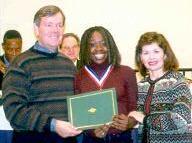
Mission
Office of Black Affairs
http://dced.utah.gov/blackaffairs/
The Office of Black Affairs assists in creating a better quality of life for Utah’s African-American community and heightening awareness and cooperation between the state’s black community and state agencies.
The black community in Utah is one of the smallest ethnic communities in the state with fewer than 20,000 residents or just slightly less than one percent of the population. The black community played a key role in the 2002 Olympic Winter Games in Salt Lake City. The perception was that people of color, particularly black people, would not participate in Olympic events. However, the talents of Utah’s black community shined throughout the Games. Baptist churches got involved through the voices of their choirs and the helping hands of congregations volunteering their time and talents for the Olympic effort. The Office of Black Affairs helped to serve black citizens and the entire community though cultural education prior to and during the Olympics.
Highlights
Teamed with State Representative Duane Bourdeaux to start a new organization the Utah Black Leadership Forum committed to addressing a myriad of issues concerning the black community.
Collaborated with the U.S. Small Business Administration to promote business development in the black community.
Worked with the NAACP and the court system on a public forum to
63
address court issues related to black people and with the Church of Jesus Christ of Latter-day Saints and the Salt Lake City School District on cultural issues.
Helped train more than 3,000 state court personnel and youth corrections staff in cultural competency.
Aided state outreach workers in assisting disabled black citizens.
Served on the Salt Lake Organizing Committee diversity committee, the state domestic violence board, and the Ogden Area Community Action Agency board.
Organized and conducted the annual Governor’s Initiative on Families Today conference for black students in Utah high schools. Governor Mike Leavitt attended and helped present achievement awards to more than 50 African-American prep students.
Provided support to the Black Education Scholarship Foundation and Juneteenth events in Utah.
Conducted presentations at schools and youth detention centers on principals of nonviolence and the history of African Americans in Utah.
Offered support to racial profiling and hate-crime legislation in the Utah Legislature.
64

Mission
Office of Hispanic Affairs
http://dced.utah.gov/hispanic/
The Utah Office of Hispanic Affairs advises the governor on issues that impact the Hispanic community in the state. To accomplish this mission, the office assesses the response of state government to the needs of Utah’s Hispanic residents.
The 2000 Census shows that Hispanics are one of the fastest growing ethnic groups in Utah, experiencing a 130 percent increase from 1990 to 2000. Their numbers rose from approximately 85,329 to more than 201,000, or approximately nine percent of the state’s population.
In the last year, Hispanic Affairs has encouraged state agencies to provide a high level of responsiveness to the needs of Hispanics.
Highlights
The Office of Hispanic Affairs:
Responded to more than 1,000 telephone calls about job discrimination, wage claims, fair housing, consumer protection, fraud, domestic violence, child abuse, complaints about enforcement, access to state agencies, mediation between Hispanic residents and state agencies, equal education opportunities, and health care.
Held public town meetings around the state with the Hispanic community to address the various issues, including immigration, wage-labor, civil responsibilities, and law enforcement procedures.
Held the 2nd Annual Cultural Integration Symposium in May 2002. The
65
symposium was conceived in an effort to create a medium of exchange and communication among Utah businesses and other organizations facing the challenges associated with an increasingly diverse work force. Intermountain Health Care, the Marriott Hotel in Provo, and Sweet Candy Co. of Salt Lake City presented their models for addressing these challenges. There were 150 participants.
Conducted, in partnership with American Express Centurion Bank and Zions Bank, several Hispanic Economic Summits along the Wasatch Front. They offered workshops on personal finances and starting a business. Other participants included the Small Business Information Center, Small Business Administration, SCORE, and local chambers of commerce. Materials were developed for the more than 250 English– and Spanishspeaking participants.
Assisted the Small Business Administration with Minority Enterprise Development Week, which included the seventh annual Minority Enterprise Development gold tournament to bring together bankers, government buyers, private-sector buyers, and minority leaders and businesses.
Partnered withIndependent Living Centers across Utah to provide guidance and input to improve their outreach efforts in the Hispanic community.
Assisted Sanpete County mental health agencies with cultural competency training for over 75 staff members to better improve their services to the Latino community.
Supported legislation that standardizes a statewide system to collect ethnic data to address racial profiling during traffic stops.
Supported House Bill 144, which was approved by the Utah Legislature. The legislation enables undocumented students to pay state resident tuition at Utah’s pubic colleges and universities.
Participated in the Civil Rights Forum in St. George hosted by the Utah Commission on Civil Rights.
66
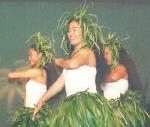
Office of Pacific Islander Affairs
http://dced.utah.gov/poly/
Mission
The Utah Office of Pacific Islander Affairs is charged with keeping the governor and state government aware of issues that impact Polynesians and Utah residents of Pacific Island descent.
The Office of Pacific Islander Affairs continues to coordinate efforts to assist Pacific Islanders to acculturate and become aware of available opportunities, therefore improving their quality of life.
Highlights
Referral Service and Community Resource: The office continued to field inquiries from Utah’s Pacific Islander population and other citizens about Pacific Islander issues. They include immigration, racial profiling, discrimination, education, job equity, health care; gang, youth, and domestic violence, substance abuse, cultures, customs, and traditions.
Joint Ethnic Work Plan (2001-2002): The Office of Pacific Islander Affairs continued to collaborate with the directors of the Offices of Asian, Black, and Hispanic Affairs on issues of criminal justice, economic opportunities, education, and health. The Office of Pacific Islander Affairs took the lead and was the primary contact on health issues.
Pacific Islander Advisory Council: The office wishes to acknowledge the contributions of the members of the Pacific Islander Advisory Council who are appointed by the governor to represent the community. The council meets monthly to bring issues from the community to the
67
attention of the office and to also take information to the various Pacific Islander communities represented by council members.
Projects Manna: The office, in collaboration with Community Connection Services, was again awarded a second year Title II federal grant from the Utah Commission on Criminal and Juvenile Justice (CCJJ) for intensive in-home services to reduce criminal behavior among Pacific Islander youth. An additional grant was also received from CCJJ to provide counseling and parenting services to Pacific Islander parents with children in youth corrections. Forty-eight Pacific Islander youths were enrolled in the classes, and 57 parents enrolled in the parenting courses.
Pacific Islander Cancer Control Network: 2002 marked the second year of a subcontract from the University of California, Irvine on a federal grant from the National Cancer Institute to conduct educational outreaches on cancer for Chamorros, Samoans, and Tongans. The Utah component overseen by the Office of Pacific Islander Affairs focuses on the Tongan population.
Racial and Ethnic Advisory Council to the US Census Bureau: As a member of REAC, the director of the Office of Pacific Islander Affairs has been attending a number of meetings preceding the release of many reports on the 2000 Census. Much of the effort of the “Native Hawaiian” and “Other Pacific Islander” sub-committee of REAC has been focused on the implementation of the US Office of Management and Budget (OMB) directive to separate the Asian and Pacific Islander demographics and the collection of data by federal and other government agencies.
Advocate for Pacific Islander Community: The director of the Office of Pacific Islander Affairs serves on several state boards and councils as an advocate for Pacific Islanders and other ethnic populations in Utah. Those panels include the Aging and Adult Services Advisory Council to the Utah Substance Abuse and Anti-Violence Coordinating Council. Service on such panels enables the office to stay abreast of key issues impacting the Pacific Islander community and to provide input on those issues. The director also works with the Pacific Council of Leaders to promote a national voice and network for Pacific Islanders.
Pacific Islanders in Correctional Facilities: The Office of Pacific Islander Affairs coordinated and arranged with Utah adult correctional facilities for Pacific Islander community and church leaders to conduct four visits to state prisons to visit Polynesians inmates. Cultural programs and inspirational talks were given to encourage Pacific Islander inmates to participate in educational offerings and other resources to establish a solid foundation for life after their incarceration. The Office of Pacific Islander Affairs director also visited individually with 70 percent of the Pacific Islander inmates in maximum-security facilities.
68

Mission
Utah Martin Luther King Jr. Human Rights Commission
http://dced.utah.gov/mlkcommission/
The Utah Martin Luther King Jr. Human Rights Commission works to promote education and awareness throughout Utah of the principles of nonviolence and respect of human rights for everyone. The commission also encourages and coordinates ceremonies and activities in Utah for the national Martin Luther King Jr. holiday, which is observed the third Monday in January.
Highlights
The tenth anniversary of the Martin Luther King Jr. Human Rights Commission was marked in August 2001 with a recognition of those who played a key role in the formation of the commission.
Introduced the “Drum Major” award, which was presented to seven people who have made a difference in promoting human rights in Utah.
Celebrated the Martin Luther King Jr. holiday in Utah in January 2002 by addressing the Legislature. William Haley, son of the late author of Roots, Alex Haley, was the keynote speaker at the commission’s annual holiday luncheon.
Continued the Adopt-a-School program, where information and materials onhuman rights are presented to schools in the state. One rural and one urban school were added to the program.
Worked with local universities on their King holiday celebrations and with the state Parent Teacher Association.
Continued with efforts to establish the commission’s Speaker’s Bureau, whose members present and explain the principles of non-violence and
69
respect of human rights to elementary, secondary, and post-secondary students.
“A day on, not a day off” continues to be the theme of the Martin Luther King Jr., Holiday celebration in Utah. The Martin Luther King Jr. Human Rights Commission emphasizes that the holiday is a time to remember, not relax. The commission says there is much work to be done as all Utahns deserve to be treated with dignity and respect.
70

Division of Indian Affairs
http://dced.utah.gov/indian/
In so many ways, Utah will never be the same following the 2002 Olympic Winter Games. The old perception, if any, of Utah’s American Indians will also not be perceived in the same light. The Opening Ceremony of the 2002 Olympic Winter Games contributed the most to this change in perception; NBC’s coverage of the Opening Ceremony Friday night (February 8, 2002) was the highest rated and most watched Winter or Summer Olympic Opening Ceremony in television history. The Opening Ceremony was viewed by 72 million people across the globe, 10 million more than the 62 million who watched the opening in Lillehammer in 1994. We are extremely grateful to everyone who had a part in this wonderful event.
In support of the Governor’s initiatives on education,the Division of Indian Affairs has focused upon the education of Indian children as a key initiative. The Division has determined that this issue must be addressed due to the extremely high rate of educational failure among American Indian students and its impact on business and economic development. Recent SAT-9 test scores indicate that American Indian students scored the lowest in all five batteries. The drop out rate among American Indian students ranges between 60-80% in the rural areas. An education plan that was developed back in 2000 was presented to the Utah State Board of Education for action on June 14, 2002. The plan contains the following provisions:
Retaining the 1-FTE for an Indian Education Specialist plus office costs. Establishing of a statewide task force to study this problem and to develop a strategy to counteract this problem.
Revising the core curriculum to include Utah Indian History as with California’s S.B. 41.
Revising teacher-training programs.
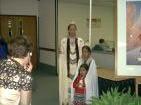
71
In an attempt to promote positive governmental relations in the Indian community, the Division embarked upon a program designed to train and produce effective leaders for the future. Empowerment Training Project has become a success! A total of 20 trainees representative of all the tribes throughout the state have competed the 10-month intensive training program.
Communications will never be the same either as the Division has recently printed its first quarterly newsletter this year. The combined winter-spring issue is available as of June 2002. We hope this information will continue to enlighten the public to the needs, activities, and the plight of Utah’s American Indians.
Forrest S. Cuch Division Director
Mission
It is the purpose of the Division to develop programs that will allow Indian citizens an opportunity to share in the progress of Utah, promote an atmosphere in which Indian citizens are provided alternatives so that they may choose for themselves the kinds of lives they will live, both socially and economically, and promote programs to help the tribes and Indian communities find and implement solutions to their community problems.
Accomplishments

Who can forget the power and pageantry of the Opening Ceremony of the 2002 Olympic Winter Games, with Utah’s Five Indian Nations entering the stadium, 500 strong representing the Olympics colors? The highlight of this year’s accomplishments was, by all means, the Opening Ceremony of the 2002 Winter Olympic Games. Much thanks goes to the Misher Producers, the Utah Tribes, their field coordinators, and everyone else who contributed to this major production.
2002 Olympic Winter Games: Besides the spectacular Opening Ceremony, American Indians were involved in the following events: Torch Relay, welcoming athletes at Olympic Village, performances at Medals Plaza, Cultural Olympiad (Discover Navajo and Great Basin Tribes of the Colorado Plateau Exhibit), The Canyons Resort (World’s Largest Teepee), Soldier Summit, and Closing Ceremony.
72
American Indian Economic Development Summit: The 5th Annual UDIA sponsored economic development summit was held October 9-10, 2002 at the WestCoast Hotel in Salt Lake City, Utah. Over 70 tribal leaders, state personnel, and private business leaders attended the summit. This conference continues to receive high regard from conference participants. A highlight of this year’s conference was a presentation entitled, “Nation-building, Tribal Government, and Leadership” by the Udall Center for Studies in Public Policy, University of Arizona. A meeting of the Task Force on Tribal Economic Development (S.B. 198) on the final day to gather testimony from the tribes concerning this bill also added to the quality of this year’s conference.
Honoring Our Youth Indian G.I.F.T. (Governor’s Initiative on Families Today) Conference: More than 500 youths and their parents attended the conference May 4, 2002 at the Jordan High School. 470 young people received awards at the conference with an additional 125 receiving rewards in the mail, 595 total awarded.
IntergovernmentalRelations: UDIA continues to facilitate a positive relationship and dialogue among Utah Tribal leaders, the Governor’s Office, and the State of Utah through its annual meeting with the governor and caucus with the Legislature held in February 27, 2001.
Indian Education: An Indian Education Strategic Plan prepared August 2000 was submitted to the Utah State Board of Education June 14, 2002. Two meetings with the Coalition of Minorities Advisory Committee preceded the meeting with the State Board. UDIA is recommending a strategic plan be implemented to include continued funding of the Indian Education Specialist at USOE and a statewide task force be formed to monitor implementation of the plan to improve the education of Indian children.
Assuring Support Services Empowerment Training (ASSET) Project: UDIA is proud to announce that a total of 20 American Indians representing all five Utah Indian nations from throughout the State of Utah completed five or more of the total of 10 training sessions conducted during the 2001-2002 year. This project was funded by the U.S. Department of Agriculture under the Rural Development Program.
Financing for Indian Tribes: As we examine existing barriers and increase access to credit and capital development for Utah Tribes and their members on reservation lands, UDIA continues to participate in Sovereign Lending workshops held throughout the year and is a member of the Federal Reserve Bank of San Francisco Sovereign Lending Task Force.
Partnerships
UDIA director served on the Salt Lake Organizing Committee of the 2002 Olympic Winter Games and maintained positive working relationships with Indian tribes, Native American 2002 Foundation, other minority groups, in promoting Utah American Indian participation in the Olympics.
UDIA-sponsored reception of Utah Tribal Leaders for American Indian Olympics representa tive Naomi Lang (Kurok) on February 23, 2002 at the Devereaux House.
73
UDIA director continues to serve in ex-officio role on the Circle of Wellness, Inc. Board of Trustees. This past year, the board purchased a 12,500 square-foot building near the Indian Walk-In Center that will be renovated into a health clinic serving American Indians living along the Wasatch Front. Partial funding for this purchase came from S.B. 44 ($300,000 appropriation for an Urban Indian Site).
Assisted Utah Museum of Natural History in implementing Native American Grave Protection and Repatriation Act grant from the National Park Service. UDIA worked with project coordinator to resolve state and federal NAGPRA issues during the period May 2001 to June 2002.
Worked with Sundance Institute in the sponsorship of another successful reception January 15, 2002 in Salt Lake City for American film producers, directors, and actors.
Legislative Initiatives
S.B. 46 Indian Affairs Related Amendments – This act modifies the Wildlife Resources Code to address issues affecting Indians. This act modifies the process for review of certain agreements with Indian tribes. This act makes technical changes.



74

Division of Fine Art
Utah Arts Council
http://arts.utah.gov/
The arts organizations in Utah continue to produce offerings that delight, educate and stimulate. They attract visitors from other states and, in many cases, from other countries. The 2002 Olympic Winter Games were greatly expanded by the offerings of our own arts companies. They rose to the challenge. Foreign visitors to our state were amazed that a state many of them had never heard of before could present such superior arts offerings. As we go forward to a lean financial year, we know that creativity is the essence of the arts community, and so it is with the Utah Arts Council staff and Board. We find a way for creative juices to kick in, and then we determine how we will try to deliver the same level of service that our constituents have come to expect.
Bonnie Stephens Director Mission
Believing that the arts are essential to a high quality of life, the Utah Arts Council serves all the people of the state as it fosters creativity, promotes excellence, and encourages diversity in the arts in Utah. In response to the legislative mandate of 1899 “to advance the arts in all their phases,” the Utah Arts Council broadens the availability and increases the appreciation of the arts by securing and distributing funds, providing training and development, and providing educational programs in the arts statewide.
The Utah Arts Council fosters creativity, promotes excellence, and encourages diversity in the arts in Utah. Through its extensive outreach programs, the Council broadens the availability and increases the appreciation of the arts in Utah’s rural, urban and suburban areas, including all of Utah’s diverse communities and ethnicity.
75
Artist Services
Artist Services provides financial assistance and recognition to Utah artists. In fiscal year 2002, 136 artists submitted applications for Artist Grants, requesting $160,451. Twenty artists were awarded up to $1,200 for a total of $24,000 in Artist Grants. Over 2,200 artists received ArtOps, a quarterly opportunities newsletter. Several hundred artists visited the Artist Resource Center (ARC). The ARC and Artist Services held or subsidized seven workshops for artists, which 160 individuals attended.


Arts Education
The Arts Education Program is committed to life-long learning about, in and through the arts. The AE program provided grants to schools and nonprofit organizations for residencies and arts education projects. The program also provided technical assistance in arts education planning/ implementation, grant writing, and arts learning and development. Educators, parents, artists, arts administrators, and nonprofit administrators in all 29 counties participated in conferences and workshops. Regional workshops were offered to all of the state's 40 school districts through partnerships with the Utah State Office of Education, Utah PTA, Utah Arts Education Association, Utah Dance Education Organization, Utah Music Educators Association, Utah Theatre Association and Art Access/Very Special Arts Utah. New initiatives in 2002 included outreach into juvenile facilities, programming for volunteer organizations, and workshops and conferences for agencies serving Utah victims of crime. The Arts Education Program also contributed to the John F. Kennedy Center for the Performing Arts Imagination Celebration held as part of the Salt Lake Winter Games Utah Cultural Olympiad. The Program's outreach expenditures in fiscal year 2002 totaled $289,738.
Community/State Partnership
The Community/State Partnership Program provides technical assistance to community arts organizations through workshops, leadership training, retreats and nonprofit education. The CSP program provided this technical assistance to over 100 arts and cultural organizations at little or no cost. This year, CSP initiated The Pilot Program, a professional development training. This two-year program impacts 18 of Utah’s underserved or rural communities. Each participant received over 80 hours of curriculum-based leadership training. CSP also administers the Utah Performing Arts Tour, which offers nonprofit organizations throughout the state the finest local, regional, and national artists and companies at affordable prices. In fiscal year 2002, the Tour subsidized performances in 50 Utah communities, reaching audiences of over 28,000 citizens. Each performance included an artist outreach residency, free of charge, that educated over 8,500 students within those communities.
76
Folk Arts
The Folk Arts Program documents traditional arts and artists; produces exhibits, festivals, concerts and educational products; and administers grants to encourage the perpetuation of traditional skills and artistry. Special initiatives during 2002 included documentation of traditional Anglo and Ute craftspeople, performers and storytellers in the Uintah Basin and community celebrations like the Swedish Lucia Festival in Salt Lake and the Laotian New Year in Layton. In conjunction with the 2002 Olympics, the Folk Arts Program produced and distributed a calendar, “The Diverse-City of Salt Lake,” celebrating Utah’s many cultural communities. Folk Arts staff also worked on special art exhibits for the Olympics featuring Utah quilts, Native American art, and photos of traditional artists and communities. The Folk Arts Program awarded seventeen grants to folk and ethnic artists and organizations statewide. Several pieces of Native American art, Mexican Day of the Dead sculptures and decorative blacksmith art were added to the State Folk Arts Collection. This year the staff was able to secure nearly $60,000 in matching funds to help support these and other folk arts projects that served over 3,000 traditional artists and approximately 200,000 audience members.
Grants

The Grants Program supports arts projects of nonprofit organizations throughout Utah. In fiscal year 2002, $1,372,228 in grants was awarded to 193 nonprofit organizations in 44 communities statewide. Attendance figures reported by grantee organizations amount to more than 4.5 million people annually.
Literature
The Literature Program assists and encourages Utah writers, at all stages of their careers, throughout the state. The program works in partnership with schools, colleges, universities, libraries, publishers, media, bookstores, and literary organizations. It also participates in readings, residencies, and other outreach activities in individual communities. The program also sponsors an annual writing competition involving approximately 300 Utah writers annually, with $1,000 first place prizes, and a $5,000 publication prize awarded. Overall, the Literature Program spent nearly $40,000 in outreach funds in fiscal year 2002.
77
Public Art
The Public Art Program places site-specific art in and around public spaces of State facilities to enhance these environments and help build healthy and beautiful communities in Utah. Site specific art placed by the Public Art Program and the selection committees can take the form of architecturally incorporated elements, landscape design, glass, textile, painting and/or sculpture. The program also aids in building a quality public art collection for the citizens of Utah by accepting proposals for public art commissions from artists in Utah and all over the United States. The Utah State Legislature did not approve funding for any new public art projects for the 2001-2002 fiscal year. However, during fiscal year 2002, $86,000 was spent on commissions approved prior to the funding stop and $6,500 on maintenance of Utah’s public art collection.
For the year 2002, in addition to the maintenance issues for the collection, the Public Art Program coordinated new projects at:
Cowles Mathematics Building, University of Utah, Salt Lake City
8th District Court, Vernal
Division of Services for the Deaf and Hard of Hearing Community Center, Taylorsville
The public art staff assisted the 2002 Olympic Winter Games Cultural Olympiad in the coordination, installation, presentation and management of public artworks by American sculptor Alan Houser and American glass artist Dale Chihuly. Projects were also coordinated displaying the Declaration of Independence in the Utah State Capitol Rotunda and a major exhibition of and about the Navajo Nation at the Olympic Museum in Laussane, Switzerland.

Traveling Exhibitions
The Traveling Exhibitions Program (TEP) is a collaborative partnership with museums, colleges, university and community galleries, arts and cultural centers, libraries and schools. In fiscal year 2002, TEP brought 23 exhibits to 85 different institutions throughout the state, including schools, community centers, libraries, colleges, and museums.
78

Division of State History
Utah Historical Society
http://history.utah.gov/
As our strategic plan states: History is not just books, not just dates, not just one story.
It’s many stories, viewed from many angles: the ancient past and the recent past, the famous and the forgotten all who have helped make us who we are.
It’s a continual pushing at the edges of what we think we know, an adventure of discovery, an important voice in public processes.
Because connections with the past are so vital to the well-being of individuals and communities, we at the Division of State Historysee our work as vital to quality of life in Utah. We help people uncover and discover the past. We seek to broaden understanding among diverse groups. We work to enhance the quality of life and economic strength in communities statewide. We help preserve and revitalize irreplaceable sites, buildings, and neighborhoods. We preserve invaluable documents and photographs
But we don’t work alone. The division is committed to partnerships, and those partnerships exponentially enhance the work. Working with others, we have created exceptional education programs, heritage tourism development, preservation and archaeological projects, conferences, publications, and more.
Through the vision of former director Max J. Evans, who resigned in June 2002, the division took full advantage of technological possibilities, using partnerships in many cases to post databases, images, catalogs, and helpful public information online.
As we look forward, the division is committed to strengthening its core programs in History, Archaeology, Preservation, and Library through innovation, teamwork, and partnerships. And we are confident that this work will continue to strengthen communities, build bridges of understanding, and enrich the lives of all Utahns.
Wilson G. Martin Acting Director
79
HERITAGE RESOURCE STEWARDSHIP
Resource preservation
The division continued to collect and preserve documentary materials that would otherwise be lost manuscripts, printed materials, limited-print and old books, and artifacts. It added more than 1,100 books and pamphlets, 38,500 photographs, and 299 architectural drawings to its collections, including 400 yearbooks solicited from Utah high schools.
The division did preservation work on unique historical film footage taken of the Glen Canyon and Grand Gulch areas by Harry Aleson. It also preserved through high-quality scans 5,000 images from the important Shipler photo collection.
The division administered about 100 CLG and Main Street historic preservation grants, totaling $407,497. These monies supported revitalization of commercial areas and created community pride and reinvestment. Through the grants, underused buildings and infrastructure on main streets increased in their economic impact. Property and sales tax revenues increased, as did investment in local communities. Also, because restoration work is labor-intensive (while new construction is materials-intensive), the grants created local jobs.
The division awarded and administered $17,000 in grants to Utah Statewide Archaeological Society chapters to help them in identifying, documenting, and preserving archaeological resources. The division also awarded more than $57,000 in grants to historical organizations engaged in various projects, including oral histories, photography, walking tour booklets, video production, building preservation, and more.
The division assisted communities in surveying and documenting 3,521 historic buildings, a preparatory step toward preservation. Staff assisted in 17 National Register listings, including two entire neighborhoods a total of 733 structures. Local citizens who wanted to stabilize and revitalize their neighborhoods spearheaded these preservation processes and used the division’s expertise to help them achieve their goals.
Division staff administered 30 cemetery grants to help cemeteries organize and computerize their records. The division maintained a comprehensive database of burials available on the Internet (currently more than 400,000 records). Family historians find the database especially valuable, but it also supports a wide variety of other research needs.
Fifty-nine historical renovation projects totaling $6.91 million in rehab and construction costs received federal or state tax credits with the assistance of the division. For every project that received a tax credit, staff worked with four or five others in some stage of the process. Some of these projects have provided moderate- or low-income housing. All have triggered private investment, helped increase property values, and contributed to the livability of their communities.
80
The division issued and administered a total of 67 archaeological survey or excavation permits.
Approximately 300 recently received project reports and 1,500 recently received site records have been accessioned directly into the archaeological database since January 2002.
The division administered $23,578 in grants and provided technical planning assistance to five proposed regional repository projects.
As a legacy of the Salt Lake 2002 Olympic Winter Games, the division collected historical materials and artifacts of the Games. This collection documents a significant historical event and will be shared and maintained as part of the state’s historical record so that future generations may imagine what it was like to be part of the 2002 Games. In all, the division added 1,433 artifacts to its collections during the year.
Heritage Area development
The division is committed to ongoing, long-term efforts in developing the state’s heritage to enhance economic development and quality of life. To that end, the division administered $225,400 in grants and worked with citizens, businesses, and local governments in seven areas of the state to 1) create a context for their heritage resources, 2) identify partners, and 3) develop projects and market the resources. The goal for each area is to receive full state and, potentially, federal designation as official heritage areas.
The division also helped spearhead three new national heritage area proposals: The Mormon Pioneer National Heritage Area (from Sanpete County to Kanab), the San Rafael Western Frontier Heritage Area in Emery County, and the Great Basin Heritage Area. Approval by Congress looks promising and could bring each area up to $10 million in federal funds for development of its heritage.
Public interaction with resources
The division’s Utah History Information Center provided information, research assistance, and photograph duplication to a wide variety of patrons, including family historians, businesses, students from grade school to college, professional authors, documentary producers, national and international publishers, and such media as the History Channel, Discovery Channel, Travel Channel, CBS, international television stations, and local stations. In all, it served 7,993 patrons and filled 2,709 photo orders.
Patrons have written: “I found so much information here.” “I found the reference librarians to be cheerful, courteous, efficient, and totally anxious to help me find the information I needed.” “It’s impossible to get the kind of care and kindness you give from Los Angeles services. Maybe it’s time to move to Utah!” “Thanks to a great genealogy source and your helping hand, you have helped reunite my family after 60 years.”
81
A film series showing historic footage of Utah sites and people drew appreciative audiences.
Members of the public seeking to preserve their own artifacts received help through the division’s Consult a Curator and Conservation Roadshow programs.
The division installed 24 National Register plaques.
Regulation
In accordance with the requirements of Section 106 of the National Preservation Act, the division oversaw compliance on 1,660 projects affecting archaeological sites and 257 projects affecting historical structures. New procedures for archaeological compliance have streamlined the review process.
The division improved and enlarged its centralized database of archaeological sites and projects. Archaeological consultants for public agencies, corporations, developers, and others use the database as they seek to comply with federal regulations regarding disturbance of archaeological sites. The coordinated Geographic Information System database, with 30,000 digitized records, streamlines nearly every stage of compliance and helps projects move forward more quickly and with fewer problems, saving time and money. The division is working toward placing the database online.
HERITAGE EDUCATION
Educational outreach
Staff and docents provided outreach enrichment programs to schools. History presentations on mountain men, mining, and pioneer use of water went to 1,649 children, and archaeologist presentations taught 1,187 children. In total, outreach presentations went to 45 schools. Staff also gave presentations to several adult audiences.
The division created and maintains teaching kits on mining, country schools, water, and archaeology and checks them out to teachers at no cost. Some 5,000 students at 30 schools enjoyed the materials and hands-on activities provided with these kits. Teachers also checked out a variety of photograph exhibits on historic themes.
Under the direction of division staff, students from two classrooms, avocational archaeologists, and other volunteers experienced hands-on archaeology at the Mushroom Springs excavation on Antelope Island. These volunteers helped at the site for a total of 22 days. Staff also conducted several public tours of the site to explain to the public how the findings at the site illuminate the prehistoric Fremont culture. Division staff also supervised 400 volunteer hours in its archaeology lab.
The Antiquities Section helped students learn about archaeology as a career by letting students shadow them and by participating in career day events.
82
Technical training programs
The division provided historical architectural consulting for a wide variety of state, local, and federal agencies. This assistance helped the agencies leverage their funds and make better preservation decisions. The division’s database of articles, how-to publications, and contractor lists provides additional resources for architects and historic property owners.
In partnership with the BLM, Forest Service, NPS, State Parks, and the College of Eastern Utah, the division initiated the first course in the Archaeological Site Stablization Education Program at the College of Eastern Utah, Blanding Campus. The academy teaches hands-on archaeological stabilization techniques to professionals and technicians and also gives heritage tourists opportunities to experience Utah archaeology firsthand. The academy will expand until it offers a full program of traditional courses and specialized seminars and workshops.
The Traditional Building Skills Institute at Snow College, which the division helped to create and continues to support, became even more successful, expanding its curriculum and filling most of its classes to capacity.
Traveling to locations around the state, the division held two regional workshops and three public meetings on repositories. It also co-sponsored the Western Archive Institute meeting in Salt Lake City, held October 29-November 9. The number of those who wanted to attend exceeded the space available; many were obliged to put their names on a waiting list.
The division curator provided technical assistance to museums seeking to set up collections programs.
Publications
The division produced four issues of the well-respected Utah Historical Quarterly. The Quarterly is now in its 70th year of publishing and preserving the latest research on Utah history for the benefit of the public and to support future scholarship. The Quarterly reached nearly 3,000 subscribers, including libraries nationwide and libraries and individuals in 22 foreign countries.
Working with the Quarterly editor, a private publisher printed two volumes of the best articles from the journal. The volumes sold well, and more volumes in the series are in process.
In partnership with the private sector, the division published and distributed 7,000 copies of Utah Preservation, vol. 6, a full-color magazine about preservation projects throughout the state. In particular, the magazine highlights the work of the division’s preservation partners.
83
The division produced volume 27 of Beehive History, which makes history from prehistoric times to the present accessible to the general public. Beehive History has been used widely by teachers and students and also goes to the members of the Utah State Historical Society.
The division produced a bimonthly newsletter to inform the public about division programs and about history activities around the state.
Educational Events
During the Olympic Winter Games, the division kept its exhibit and bookstore open until 10 p.m. Staff volunteered for evening hosting duties and welcomed guests from all over the world as they explored the state’s history. Because of these extended hours many Utah residents had their first encounter with the division museum and programs and promised to return. 10,000 people visited the museum during February 2002.
The division’s exhibits attracted 46,317 individual visits during the fiscal year. 2,198 of these visitors were school children participating in docent- and staff-led tours created and organized by division staff. Many of the visitors came as part of a new division event that made history come alive for families: History for Halloween.
Elementary school teachers have commented: “I was fascinated with the history and how the docent brought it to life for the students.” “This is wonderful!” “I am bringing my husband back with me.”
The Annual Meeting of the Utah State Historical Society attracted 300-400 people, generated and disseminated first-rate scholarship, and provided a valuable venue for networking and sharing ideas.
Some 200 people who attended the division-sponsored Statehood Day in Fillmore connected with the history and historical treasures of the central part of the state. The event generated greater interest in and awareness of Fillmore and surrounding areas.
The annual Prehistory Week, presented by the division and its partners, drew attention to Utah archaeology in 22 events around the state. Division archaeologists led tours filled to capacity of Danger and Jukebox Caves. More than 500 people, mostly families, attended the Prehistory Open House at the Rio Grande, where they learned about the early peoples of Utah through hands-on activities. The division received more than 150 entries in its annual Prehistory Week poster contest.
The 2002 Brown Bag lecture series at the Rio Grande Depot highlights sports in Utah and draws some 30 people monthly.
84
Internet presence
The division began to prepare for the 2002 Olympic Winter Games in Salt Lake City three years ago. Anticipating the interest of visitors and media in Utah’s unique history, staff members created a Utah history Web site, History to Go. The site, http://historytogo.utah.gov, is an online encyclopedia of Utah history from its geological beginnings to the present. Students, teachers, and others continue to use it as a valuable resource. A newly added feature, “History Lessons,” provides online learners with a course syllabus for Utah history.
A Salt Lake City tour guide commented, “I have just discovered this site and I wanted to tell you that I think it is outstanding. Thank you for your good work on the public’s behalf.”
Staff responded to more than 4,800 student requests for information on Utahhistory. Most queries could be answered by a referral to the division’s history site for students: http://utahhistoryforkids.gov.
A student commented: “My teacher went on this site. It was really cool! So I went on. I did the test. I passed. I have an A+ in history. It is my favorite subject…. You have the coolest site.”
The division posted online 5,000 one-of-a-kind photos from its Shipler Collection; the public can browse and search the photographs by subject. These can be found at http:// history.utah.org/photos/C275/. Using the Shipler Collection, the division has created an online exhibit relevant to the current State Capitol renovation. More than 150 images document the building’s original construction.
A Heritage Tourism Toolkit created by the division provides practical tools for communities wanting to develop, manage, and protect their heritage resources. The toolkit gives help with managing and protecting resources, forming partnerships, communicating, funding, and more. The site address is http://history.utah.org/httoolkit.
The division’s Marketplace Web site won the CIO Award for “Outstanding Online State Applications” this year.
PARTNERSHIPS AND NETWORKING
The division organized a meeting of the Oral History Consortium, a grouped formed by the division that includes institutions and individuals who collect and archive oral histories. Using a grant from the Library Services and Technology Act, staff continued to post online information on oral histories available in libraries and other repositories in the state. Eventually, the site will provide a complete, searchable list of oralhistories available at in-state repositories.
Working with the Bureau of Land Management, the division oversaw the Southern Utah Oral History Project, which focuses on the history of the Grand Staircase-Escalante National Monument area. 138 oral histories have been completed, transcribed, and placed in repositories.
85
The division joined with partners to sponsor an Archaeological Site Stewardship conference in Blanding, which drew representatives from federal and state agencies and nonprofit organizations as well as individual citizens.
The division collaborated with the Utah Division of Indian Affairs and the Utah Museum of Natural History to obtain a grant from the National Park Service to coordinate compliance and communication regarding the Native American Graves Protection and Repatriation Act. With these partners, the division sponsored two conferences aimed at improving communication between agencies and Utah tribes.
The division worked closely with the state’s Native American Remains Repatriation Committee to implement statutes and regulations regarding repatriation of Native American human remains in Utah.
The division’s affiliates program now has 189 affiliates, including Utah Statewide Archaeology Society chapters, Certified Local Governments, and local historical societies. Affiliates receive the division newsletter, are invited to workshops, and may use the division’s Web site as a host for their own Web page.
Over the fiscal year the division doubled the number of volunteers it recruited and supervised. Currently 35 volunteers further the mission of the division, donating a total of 3,414 hours over the course of the year.
The division worked in ongoing formal partnerships such as the Interagency Task Force, Utah Historic Trails Consortium, Utah Heritage Product Alliance, and Community Cultural Heritage Coordinating Council.

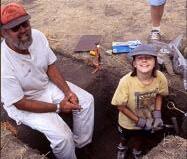

86

Division of State Library
http://library.utah.gov/
The year 2002 has been full of accomplishments and challenges for Utah’s libraries and for the State Library Division. Challenges – as always – include doing more with less and keeping up with the library technology tsunami. But the accomplishments are amazing! Consider the following highlights for library facilities in Utah.
Salt Lake County’s Hunter Branch doubled patron and collection space.
Davis County expanded the Central Branch in Layton.
The county bookmobile libraries serving Sanpete County and the Uintah Basin both moved to new facilities better suited to serving the public on site.
Provo opened a 100,000 square foot new library at historic Academy Square.
Lehi opened an expanded public library facility.
Voters in CedarCity and Washington County both approved major bonds for new and expanded library facilities.
The Marriott Library at the University of Utah and the Merrill Library at Utah State University both received a legislative “green light” to plan for future building needs.
The State Library Division staff, in addition to normal responsibilities, achieved several milestone events:
Launching a Library Assistive Technology initiative with federal grant funds.
Helping public libraries prepare to receive technology grants from the Bill & Melinda Gates Foundation.
Completing a major evaluation of the Utah Library Services and Technology Act program (1997-2002) and preparing a new five year plan (2003-2007).
Initiating a multi-year initiative to replace the aging boxes on county bookmobiles.
Completing the 21st Century Library Needs Assessment.
Initiating a major public information campaign about the services of the Utah Regional Library for the Blind and Visually Impaired.
Launching the UTAHgils Government Information Locator Service to improve access to Utah state agency information and publications.
87
I invite you to read more about these accomplishments and the Division’s service programs (Library Development, Information Resources, and the Regional Library for the Blind) in the following report.
Amy Owen Director
MISSION STATEMENT
The mission of the Utah State Library Division is to strengthen and improve library and information services to the people of Utah in order to enable them to make a living and to make a life.
ÿ We provide all Utahns with qualifying visual and physical disabilities access to quality library services and the special format materials them need in order to enjoy recreational reading, to engage in lifelong learning and to improve their economic self-sufficiency.
ÿ We provide services and training to library service providers, public library board members, and elected officials; offer resources, services and grants to libraries; and facilitate library participation in consortia and other cooperative bodies in order to strengthen the capacity of Utah’s libraries to deliver quality library service.
ÿ We provide access to Utah government information in both print and electronic formats for citizens, state employees, and elected officials in order to contribute to effective and efficient government and an informed citizenry.
REGIONAL LIBRARY FOR THE BLIND
The Regional Library circulated 270,513 cassette tapes, Braille books, large print books and descriptive videos to 14,301 patrons during the 2002. (See http://library.utah.gov/blind.html for more information.)
The Regional Library benefited from over 48,109 volunteer service hours. This is equivalent to 23 full time employees – more than the total number of staff in the program.
The Regional Library had a very successful summer reading program for blind or visually impaired children. Participants read a combined total of 45,589 minutes. Many prizes were donated by various businesses. The most popular were tickets from the Paralympics.
Patron Comments: Regional Library for the Blind
“I cannot express enough my appreciation to you for all the time you spend picking out and sending books to John. He was in a terrible accident 13 years ago that left him blind, head injury and his left side is paralyzed. He spends all his time listening to the books. I work two jobs and so this is a great blessing to have his time filled. You are a great service…you make someone happy everyday.” (Spouse of a patron)
88
“You mean everything for me absolutely everything to me. I don’t know how I could get through the day without your audio books. I use at least one tape every day . . .”
(An 81-year-old patron)
“…This service uplifts my spirit and gives me happiness and hope for tomorrow.” (A patron who is blind and serving time at the State Prison).
“All too often, I have noticed that supervisors bear the brunt of dissatisfied customers wrath. Usually good workers go unnoticed. I have not had the pleasure of being a library patron long, but I think it is a wonderful service. I have called in several times and have always been impressed with the responsiveness of the staff, especially Colleen Eggett….” (A new patron, 25 years old)
“Thank You! Thank You! for the tickets to the Paralympics. We were greatly inspired by the athletes, the atmosphere was exciting. It was great. (Heidi, 12 years old)
“It was awesome! I think the Paralympics is better than the Olympics, because they have a disability and still go just as fast or faster . . .” (Troy, 10 years old)


LIBRARY DEVELOPMENT PROGRAM
The Library Development Program documented a remarkable, ten-year period of growth in public library service in the report, Utah Public Library Service: A Decade of Growth 1990-2000. The decade covers the pre- and post-Internet era for public libraries, and it is unlikely that there will ever be another ten-year period in which library service in Utah changes so dramatically. While Utah’s population rose 29.6%, public library circulation rose an astounding 73.3%. (See the full report at http://library.utah.gov/Decade_Of_Growth.pdf
A three-year effort to assess the condition of Utah’s public libraries was completed with the publication of the 21st Century Library Needs Assessment. The study documents the condition of public library facilities, the service demands of their users, and the governance and funding options available to meet library service needs in the new century While demand for both traditional and high tech library services is rising steeply, the state’s public libraries are old onefourth are more than 70 years old and inadequate to meet the need. Local governments will require help and incentives to build libraries that can deliver 21st Century library services to Utah’s citizens. Phase II of the 21st Century Library Initiative will address this need. (See Highlights, the Executive Summary, and the Final Report at http://library.utah.gov/21stcentury. html)
Over the last year, eighteen public librarians completed the UPLIFT Certification Training, consisting of four week-long courses taken over a period of two years. Their library patrons are now benefiting from their librarians’ newly acquired competencies. Through two-dozen Division-sponsored workshops and teleconferences on a variety of library topics, 275 librarians and library board members obtained current knowledge and skills to increase their capacity to meet their professional and public responsibilities.
89
Utah’s academic, public, and school libraries used more than $554,000 in Library Services and Technology Act (LSTA) competitive grants to enhance and deepen their technological infrastructure and service capacity. Of particular importance has been the LSTA Assistive Technology Initiative, which has placed library technology for the blind and visually impaired into grant recipient libraries, thus extending services to hundreds of persons who were previously excluded from the full benefits of the new library infomation technology.
In an intensive effort extending over 20 months, the State Library Division, with the participation of librarians and library board members statewide, completed an unprecedented, formal evaluation of Utah’s federal program – the Library Services and Technology Act (LSTA). Based on the findings, the Division, with the State Library Board and the Utah LSTA Advisory Council, framed a new five-year LSTA Plan for 20032007 to serve as a foundation for the next five years. (See the evaluation report at http:// library.utah.gov/LSTA5YrRptFinal.pdf and the new Utah LSTA Five-Year Plan, 20032007 at http://library.utah.gov/lsta_5yrplan_03-07index.html
State-funded Public Library Development Grants were awarded to 70 public libraries. Funds were used creatively to extend technology, build specified areas of library collections, provide public programming, or otherwise enhance services beyond what strained local budgets would support.
Division staff consulted with librarians, library board members, and local elected officials on library service topics ranging from library governance relationships and starting a new library, to information technology and library facility construction.
Two new libraries were certified under Utah’s statewide public library service standards Eagle Mountain Public Library (Utah County), and Newton Town Library (Cache County) bringing the total to 72 cities and counties providing certified library service to their residents.
The Library Development Program completed the first installment of the 21st Century Bookmobile Project in overseeing the construction of two new bookmobiles to replace two of 15 seriously aging units now serving 22 of Utah’s rural counties. Library patrons of all ages across the state will benefit for decades to come from the 21st Century Bookmobile Project, which was funded by the 2001 Legislature. Two new bookmobiles are planned annually through 2008. (See the full report at http://library.utah.gov/dful0602. html#21st. )

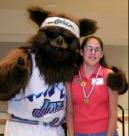
90
Customer Comments: Library Development Program
“Workshops are very helpful and needed.” (A public librarian)
“Being successful with [LSTA] grants and receiving money through this process is like ‘priming the pump’ for many participants. Some mentioned how this money seems to draw and attract more money and support from other sources. It allows for greater success and makes it easier to find matching funds.” (LSTA Grant Evaluation Report)
“LSTA equalizes the resources available, even to small rural libraries throughout the state.” (LSTA Grant Evaluation Report)
INFORMATION RESOURCES PROGRAM
This year Utahns searched the premium databases sponsored by Public PIONEER over 246,000 times, retrieving nearly 531,000 items. The website for Public PIONEER: Utah’s Online Library was redesigned for ease of use and to provide more access to information. Public PIONEER premium databases include full-text magazine and newspapers, business and health information, biographies, photographs, literature, and the archives of two of the state's largest newspapers. It also offers government information, links to Utah libraries and library catalogs, information about Utah on the web, a wide array of Internet resources, and more. (See Public PIONEER at http://pioneer.utah.gov/ )
Information Resources staff developed the UTAHgils Government Information Locator Service. This website is designed to help Internet users quickly, accurately, and easily locate needed information from Utah state and local governments. (See the website at http://pioneer.utah.gov/ gils.html
The Information Resources Program continued to catalog, index and distribute the publications of Utah state government agencies to depository libraries across the state. An additional 1,914 items have been added to the Division's catalog, which has links to online state publications.
The Information Resources Program provided to public libraries and state agencies over 6,200 items from the State Library's collection and over 11,000 from other libraries across the state and nation.
The program offered 19 Internet training workshops for public libraries and state agencies, and provided comprehensive information location assistance for state employees.
The program distributed over $200,000 in federal funding under the Library Services and Technology Act (LSTA) to 21 libraries in Utah to support library resource-sharing programs.
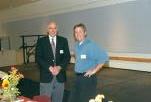

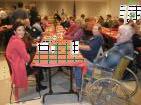
91
Customer Comments: Information Resources Program
“Patrons think we can work miracles and PIONEER helps us to be able to.” (A public librarian)
“I like the way subjects and topics are organized in PIONEER.” (A public library user)
“Now this is an excellent resource.” (The Shifted Librarian reviewing the UTAHgils Government Information Locator Service and its training resources on RSS.)


92
























































































